
7 Best Sailboat Autopilot Systems

Essential in increasing efficiency, safety, and convenience, marine autopilots are a sailor's best friend when out there on the water. A properly operating sailboat autopilot will keep your sailboat on a selected course even in strong currents and winds and that why you need to go for the best sailboat autopilot.
Steering a sailboat is always fun. And even though many sailors are so good at it, some circumstances can make steering a boat on a straight line or the right course almost impossible. The tides, winds, and the complex hull-bottom designs can throw your sailboat off route and the adjustments that you have to make to return to course can be your voyage killers. Even if you have a crew that regularly sails with you, having an autopilot can help you stay on course and that's exactly why you need the best sailboat autopilot.
In the simplest term possible, an autopilot is an extra pair of hands that can help you in steering your sailboat on the right course. It is a self-steering device for powerboats or sailboats and even the most basic autopilot can help in holding your vessel on a pre-set compass course. Some advanced autopilots can even gather data from your boat and determine whether or not the boat is capable of handling the task in hand.
So whether you have a mechanically-steered boat or a tiller-steered sailboat, an autopilot is of great importance for both you and your boat. And it doesn't matter whether you want to explore your nearest lake for a day or want to sail to the Caribbean on your sailboat, it will make your job a lot easier, efficient, and safer. This is why we've put together this article to help you find the best sailboat autopilot. Read on and find which is best for you and your sailboat.
Table of contents

How to Choose the Best Sailboat Autopilot for Your Vessel
When it comes to choosing the best sailboat autopilot for your vessel, the easiest thing to do would be to go for an autopilot that can steer your sailboat in calm seas. However, this is not advisable since you want an autopilot that works perfectly under very demanding sea conditions. With that in mind, here are the most important things to consider when looking at the best sailboat autopilot for you.
Speed of Helm Adjustment
The best way to measure the speed on an autopilot that's appropriate for your boat is by looking at the number of degrees per second of helm correction. As such a 40-feet boat requires 10 degrees per second, a 25-feet boat requires 15 degrees per second, and a 70-feet boat requires 5 degrees per second.
An above-deck or below-deck Autopilot
Do you want an autopilot that's designed to be used above the deck or below the deck? Well, the most important thing is to choose an autopilot that matches the displacement of your boat. More importantly, above-deck autopilots are ideal if you have a smaller boat while below-deck autopilot is ideal if you have a larger boat.
The Steering System
What type of steering system does your boat have? It's important to understand whether your boat has rotary drives, linear drive, or hydraulic drives.
Control Interfaces
You should choose what's perfect for you as far as the control interface is concerned because this is one of the most crucial parts of an autopilot. The best features to consider include ease of use, waterproof, intuitive display, backlit options, and compatibility with SimNet, SeaTalk, and NMEA 2000.
7 Best Sailboat Autopilots
Here are the 7 best sailboat autopilots.
Raymarine ST1000 Plus Tiller Pilot
(Best for Tiller-steered Sailboats)
The Raymarine ST100 Plus Tiller Pilot is a classic tiller pilot that's one of the best accessories for your sailboat and your everyday sailing escapades. It's designed in such a way that it can accept NMEA data while still offering accurate navigation thanks to its incredibly intelligent software.
This autopilot is designed with a backlit LCD to help you see your navigational data, locked course, and other important information that can make your sailing safer and much better. The fact that the backlit LCD works perfectly in low-light conditions is an added plus.
That's not all; the ST1000 comes with an AutoTack feature that works like an extra hand when you're engaged in other responsibilities. For example, it can tack the sailboat for you when you adjust the sails. Better still, this autopilot is fully-fitted with everything that you need to install it on your sailboat and use it.
- It's easy to use thanks to the simple six-button keypad
- It's perfect when sailing in the calm sea as well as in stormy conditions
- It is waterproof so you don't have to worry about it getting damaged
- Its intelligent software minimizes battery usage thereby prolonging its battery life
- Perfect for tiller-steered sailboats
- The 2-year warranty could be improved
- It's a bit heavier
Garmin Ghc 20 Marine Autopilot Helm Control
(Best for Night Sailing)
If you're planning to go on a voyage, chances are you'll find yourself sailing overnight. With that in mind, you should go for an autopilot that works perfectly both during the day and at night. The Garmin Ghc 20 Marine Autopilot Helm Control is your best sailboat autopilot for these types of adventure.
This amazing autopilot is designed with a 4-inch display that can improve your nighttime readability. This display is glass-bonded and comes with an anti-glare lens that is essential in preventing fog and glare in sunny conditions. This is crucial in helping you maintain control in all conditions, both during the day and at night.
This autopilot also provides a 170-degree viewing angle. This is essential in viewing the display at almost any angle. So whether you're adjusting the sails up on the deck or grabbing an extra sheet below the deck, you can be able to look at the display and see what's going on. So whether a sailing vessel or a powerboat, this autopilot is easy to use thanks to its five-button control.
- The five-button control makes it easy to use
- Comes with a bright 4-inch display
- The display works in all conditions thanks to its glass-bonded, anti-glare lens
- The display offers optimal view both during the day and at night
- It's compatible with other Garmin products
- Only good for sailboat under 40 feet in length
- The battery life should be improved
Simrad TP10 Tillerpilot
(Best for 32-feet or less Sailboat)
For many lone sailors, going with a sailboat that measures 32-feet or less in length is always ideal. Under such scenarios, it's always best to go with a sailboat autopilot that's perfect for such types of boats, and the Simrad TP10 Tillerpilot can be a superb option for you. This autopilot is so perfect as it brings to the table a combination of advanced technological software and simplicity.
Its five-button display makes it user-friendly, easy to use, and perfect in controlling your sailboat accordingly. This autopilot has a low-power draw, which means that your battery will last longer even when used for prolonged periods. This is an excellent autopilot that's designed with the sailor in mind as it goes about its business quietly so that you can enjoy your sailing adventures without noise and interruption from a humming autopilot.
- One of the quietest sailboat autopilots
- The battery life is excellent
- It's designed with one of the most advanced software
- It's waterproof to protect it from spray and elements
- It offers precision steering and reading in all types of weather conditions
- It's easy to use and control
- Not ideal for big boats
Raymarine M81131 12 Volt Type 2 Autopilot Linear Drive
(Best for Seasonal Cruising)
For those of us who love cruising during winter when other sailors are drinking hot coffee from the comfort of their abodes, the Raymarine M81131 is the right sailboat autopilot for you. Well, this autopilot can be an ideal option if your sailboat is large enough to have a full motor system.
This autopilot is one of the most powerful in the marine industry and has an incredible electromagnetic fail-safe clutch. This autopilot is also compatible with other devices such as NMEA 2000 ABD SeaTalk navigation data. In terms of precision navigation, this autopilot will never disappoint you in any weather condition.
So whether you're looking to go ice-fishing or sailing the oceans during winter, this is your go-to autopilot.
- Offers optimal sailing experience and navigation precision
- It's very quiet
- It offers high performance with minimal battery usage
- It's great for adverse winter conditions
- It's expensive
Furuno Navpilot 711C Autopilot System
(Best for Accuracy)
If you're looking for the best sailboat autopilot that will take your navigation to the next level in terms of accuracy, look no further than the Furuno Navpilot 711C. This is an autopilot that enhances your boat's precision as far as staying on course is concerned. This is because the autopilot is designed with a self-learning software program that offers step by step calculations of your navigation and course.
This autopilot also offers real-time dynamic adjustments so that you can steer your sailboat more accurately. Thanks to this self-learning algorithm also offers great power application that significantly reduces the manual helm effort when maneuvering various situations. Its colored graphic display is of great benefit as you can easily read the information even in low-light conditions. So it doesn't matter whether you're sailing at night or during the day, this autopilot will serve you right in any condition.
- It's great for power and fuel efficiency
- The display is intuitive
- It's easy to set up and use
- Its power assist is essential in reducing steering system complexity
- Great for both outboard and inboard motors
- Quite expensive
Si-Tex SP120 Autopilot with Virtual Feedback
(The Most Affordable Autopilot)
If you're on a budget and looking for one of the most affordable yet reliable sailboat autopilots, look no further than the Si-Tex SP120 Autopilot. This is a perfect high-performance sailboat autopilot that can be great for small to medium-sized powerboats and sailboats.
One of the most important features that this autopilot brings to the table is the ability to offer virtual feedback. This is great in eliminating the manual rudder feedback and thereby enhances your sailboat's performance. Its splash-proof 4.3-inch LCD offers one of the best transflective displays in the marine industry. The 4-button operation makes it a lot easier to use and provides the information you need to steer your sailboat safely and perfectly.
This autopilot can be great for you if you have a small or medium-sized sailboat thanks to its ease of use. The fact that it's one of the most affordable sailboat autopilots makes it highly popular with sailors who are on a budget.
- It's simple to install and use
- The virtual feedback is great
- The display is one of the best in the game
- It's quite affordable
- It's not ideal for big boats
Garmin Reactor 40 Kicker Autopilot
(Best for Outboard Motor Boats)
If you have a motorboat that has a single-engine outboard, The Garmin Reactor 40 Kicker Autopilot can be an ideal option. This is a great autopilot that mitigates heading error and unnecessary rudder movement while offering more flexible mounting, which is essential in offering a more comfortable sailing even in the roughest of weather conditions.
This autopilot can be easily fine-tuned thanks to its throttle settings with a touch of a button. Of course, this can be useful especially when the seas are rough and you're trying to remain on course. This autopilot is also waterproof to ensure that it doesn't get damaged with spray or other elements.
With this autopilot, you're guaranteed to enjoy an awesome sailing trip even when going against the wind or when sailing in rough conditions.
- Easy to install and use
- It's waterproof
- It's beautifully designed
- It comes with a floating handheld remote control
- It's great for maintaining heading hold and route.
- It's only ideal for motorboats with up to 20 horsepower
- It's relatively expensive
As you can see, there are plenty of options when it comes to choosing an ideal sailboat autopilot for you. The best thing about the above-described sailboat autopilots is that they're among the best and you can find one that perfectly suits your unique needs and boats. Of course, most of them are quite expensive but they will advance the way you sail and make your sailing adventures even more enjoyable. We hope that you'll find the perfect sailboat autopilot for you.
Until next time, happy sailing!
Related Articles
Daniel Wade
I've personally had thousands of questions about sailing and sailboats over the years. As I learn and experience sailing, and the community, I share the answers that work and make sense to me, here on Life of Sailing.
by this author
Sailboat Upgrades

Most Recent

What Does "Sailing By The Lee" Mean?
October 3, 2023

The Best Sailing Schools And Programs: Reviews & Ratings
September 26, 2023
Important Legal Info
Lifeofsailing.com is a participant in the Amazon Services LLC Associates Program, an affiliate advertising program designed to provide a means for sites to earn advertising fees by advertising and linking to Amazon. This site also participates in other affiliate programs and is compensated for referring traffic and business to these companies.
Similar Posts

How To Choose The Right Sailing Instructor
August 16, 2023

Cost To Sail Around The World
May 16, 2023

Small Sailboat Sizes: A Complete Guide
October 30, 2022
Popular Posts

Best Liveaboard Catamaran Sailboats
December 28, 2023

Can a Novice Sail Around the World?
Elizabeth O'Malley
June 15, 2022

4 Best Electric Outboard Motors

How Long Did It Take The Vikings To Sail To England?

10 Best Sailboat Brands (And Why)
December 20, 2023

7 Best Places To Liveaboard A Sailboat
Get the best sailing content.
Top Rated Posts
© 2024 Life of Sailing Email: [email protected] Address: 11816 Inwood Rd #3024 Dallas, TX 75244 Disclaimer Privacy Policy

My Cruiser Life Magazine
6 Best Sailboat Autopilot Systems
Hand steering a sailboat is so much fun – until it isn’t. In actuality, it’s tiring work that requires more concentration than we can give it for very long. Racing sailboats switch helmspersons regularly, and offshore passagemakers never rely solely on hand steering. In fact, a breakdown of automatic steering is a big problem for a short-handed vessel offshore.
Sailboat autopilot come to our rescue again and again. These crewmembers don’t need sleep, food, or water, and they never complain much. So let’s take a moment to appreciate these wonders of modern technology, and credit them with what they make possible. Here’s a look at the inner workings of Otto the Pilot, including his care and feeding.
Table of Contents
What is a sailboat auto pilot how does it work, what can an autopilot do, what can’t an autopilot do, mechanical windvane, electrical sailboat autopilots, control head, computer, “black box,” or “core pack”, rudder angle sensor, other input sensors, size and displacement of your vessel, types of drive unit, functionality and integration with mfd, small boat tiller pilots, below deck autopilots, sailboat autopilot faqs, navco/b&g, simrad, lowrance.
At the most basic level, the purpose of an autopilot is to steer the boat so you don’t have to. Steering a boat is like steering a car–every bend and curve in even a straight road will set the vehicle on a new course. So while sailing, every wave will wiggle the boat around. What’s more, the boat’s designed-in weather helm tendencies will cause it to want to head up into the wind. So steering a sailboat requires constant attention and work.
After about 30 minutes, even the best helmsmen will start to waiver. An autopilot relieves you of some of this workload. It allows you to safely stand watch at the helm for hours at a time because you don’t have to worry about every bump, wave, and wind gust blowing you off course.
Do Boats Have Autopilot?
Of course, not every boat has an autopilot. It likely doesn’t need one if the boat is designed for day sailing. Half the fun of day sailing lies in the handling of the boat–the actual sailing part! Having an autopilot might be handy, but it’s hardly a necessity.
But boats that are built to travel for hours, days, or weeks at a time need an autopilot of some sort. There are many types of autopilots out there, even some mechanical ones that require no electricity . They vary in functionality, but their basic purpose is to relieve the helmsperson of some of the work.
With that in mind, all autopilots can perform some basic functions. No matter how basic they are, they can all hold the boat’s course and points of sale in a relatively straight line. How they accomplish this depends on their complexity and what sort of sensors or inputs the autopilot has to understand the world around it.
Advanced modern autopilots usually have three modes you can select from. They can hold a compass heading, a bearing off of the wind, or hold a GPS course to the next waypoint.
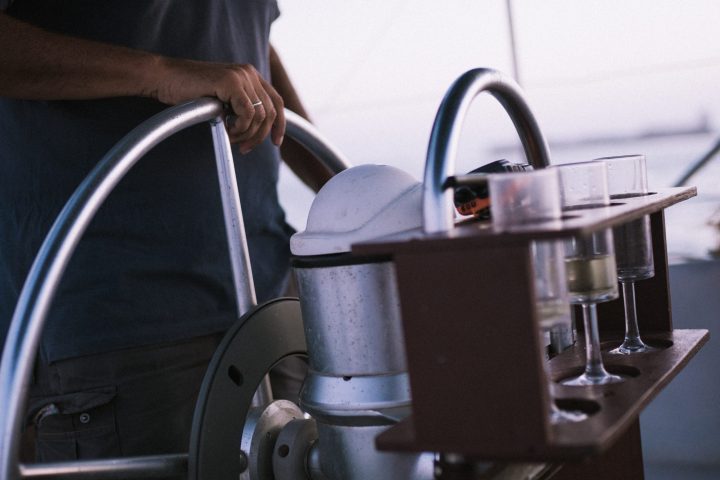
As amazing as autopilot is and as much work as they can do for us, they have some very big limits. What can’t an autopilot do? It can never replace an able helmsperson exercising good seamanship.
What does that mean? First and foremost, it is the legal responsibility of every vessel operator to maintain a continuous lookout. This is one of the most fundamental regulations in the COLREGS – the international laws set to prevent collisions at sea.
In other words, only a human standing watch and looking out for hazards can see and avoid those hazards. An autopilot has no sensors to understand the world around it in that way–it can’t see other ships, boats, landmasses, rocks, or markers. So if it’s holding its course and something is ahead of it, it will run right into whatever lies in its way.
Many new sailors want to know if they can sleep while the autopilot drives the boat. The autopilot will certainly keep driving the boat–but it will keep driving it forever–onto the beach, into the side of a container ship, or straight into a metal day beacon.
Another thing that autopilots don’t know is when to stop. They keep going until the helmsman switches them into “standby” mode. Here’s a horror story that I’ve heard a few times–it’s the middle of the night, and the boat is on autopilot. The skipper needs to pee, so he walks to the stern rail and falls off. His wife awakes two hours later for her watch, only to find an empty boat that’s still steering a perfect course away from her dear darling husband.
Now, ladies, before you get any ideas, this is supposed to be an illustrative and cautionary tale about autopilots, not marriages.
Types of Autopilot
It’s impossible to understand the role and purpose of modern autopilots without first discussing the tried and true mechanical windvane.
The windvane is a simple item mounted to the back of the boat. Above the water is a windvane that swings to point into the wind. Through a series of linkages, it is attached to a rudder below the water–either its own rudder or attached to the boat’s rudder.
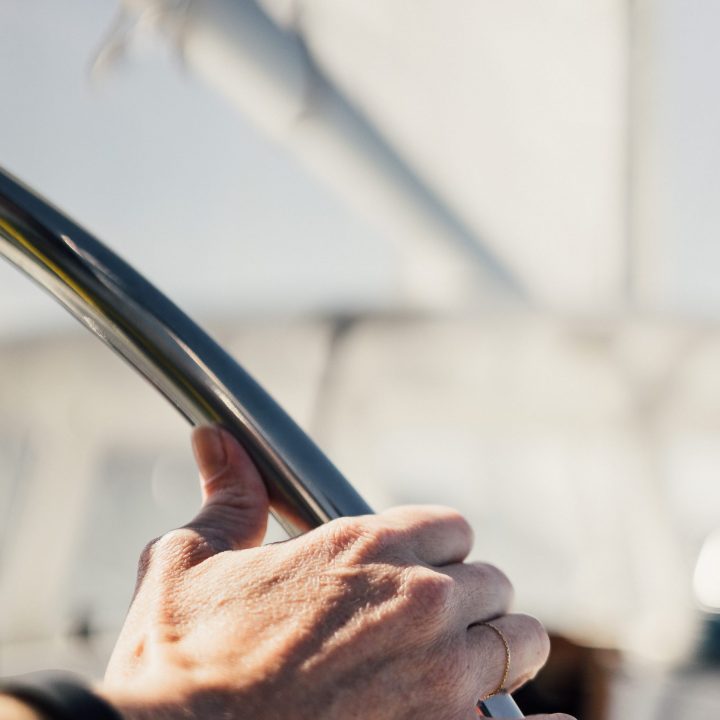
The skipper uses a line to select the direction off of the wind – using the windvane – that they wish to steer. The windvane then corrects for any changes by moving its rudder left or right.
The windvane is pretty simple in theory and ultra-reliable. Before the days of solar and wind generators , the fact that they used no electrical power was their biggest selling point. They’re still popular with offshore sailors today, mostly because of their reliability and simplicity. While a lightning strike could take out every electrical component on your boat, it wouldn’t hurt a windvane.
For all its plusses, the windvane has some limitations. It only works when sailing in steady winds–if you’re trying to hold your course while motoring on a windless day, it won’t do much. They are also large and bulky, mounted on the stern of the boat in a place where most coastal sailors want to have their dinghy or a nice swim step.
Electric autopilots are a technology borrowed from the powerboat world. There’s fundamentally no difference between a sailboat autopilot and one built for a powerboat.
Above-Deck or Cockpit Autopilots
An above-deck autopilot has all of its components mounted at the helm. It’s a simple and less expensive solution popular with smaller coastal cruising boats.
For a basic autopilot like this, an electric mechanism will turn your steering wheel or tiller. It works fine on smaller boats and in calm conditions. However, the drive units are not powerful enough to move a big boat or a boat in very rough conditions . These units are commonly called wheel pilot and tiller pilot systems.
Below-Deck or Inboard Autopilot System
The best solution, albeit the more expensive and complicated one, is the below-deck autopilot. The rudder is turned by a series of servo motors or hydraulics below decks.
The biggest advantage of most of these systems is that the autopilot usually has its own attachment to the rudder post. In the event of a steering failure, the autopilot will often still control the boat just fine.
Another advantage is that the autopilot drive motor can be sized correctly for the vessel. Hydraulic rams that produce incredible force can be mounted. These can control any vessel in any sea condition if sized correctly.
Sail Boat Auto Pilot Components
Today’s autopilots are complex electronic systems built of several components that work together to get the job done. Most advanced autopilots consist of the following parts.
- Control head
- Electronic flux-gate compass
- Black box computer or core pack
- Rudder position and other sensors

There must be some controls for the helmsperson to manipulate the helm of the boat . This is usually in the form of an instrument-sized control head that monitors and controls the autopilot system.
The autopilot computer cannot know the compass course of the boat without having an electronic flux-gate compass. It is usually mounted somewhere in the boat far from other electromechanical systems, like a locker in the stateroom.
The autopilot’s processor will have a central black box that receives input from its various sensors. It also directly controls the drive motor, telling it when to come on and which direction to steer with how much force.
The drive unit mounts to the rudder post of the boat. It is generally preferred that the drive attach directly to the post so that if anything on the regular steering system breaks, the autopilot will still function. In the case of an above-deck autopilot, the drive unit is usually a simple electric motor or a magnetic servo mounted to the wheel.
There are a few methods of below-deck drive that can be matched to the vessel’s existing steering system. For example, powerboats with outboards often have hydraulic steering installed. In addition, there are autopilot drive systems that you can install in line with this existing system.
The most common type of drive on sailboats is the linear ram drive. This is a rod that pushes straight in or out. When mounted to an arm on the rudder shaft, it can turn the rudder through its full range of motion.
The ram can be powered by either an electric motor of the sailboat and gears or hydraulics.
A position sensor is mounted on the rudder shaft to ensure that the autopilot knows the rudder’s angle. It operates an indicator on the control head. But more importantly, it helps calibrate the system to know where the center is and how much deflection is given to each side.
The complexity of your autopilot is also dependent on how many other electronics are networked into the autopilot computer. Most marine networks now work on the NMEA2000 standard. If that’s the case, and your autopilot talks to your other instruments, you’ll likely get a few extra benefits.
If you have an electronic wind instrument onboard, your autopilot will be able to hold a true wind angle. This is a great way to run a cruising boat and like using an old-school windvane.
For example, you might be running a course to your destination and find it sailing downwind . Instead of risking an accidental jibe with your boat , you set up a course with the wind 160 degrees to starboard. The autopilot will hold that wind angle for you, even if the wind shifts slightly. Then, you can determine when, where, and if you need to jibe.
If your autopilot “talks” to your MFD (multi-function display), you can get even more options. If you plot a course directly to a waypoint, your autopilot can track the sailboat on that line using the “Navigation” function. Remember that it won’t know what to do when you get there, so it will likely deactivate itself. It’s just holding that pre set compass course.
Alternatively, you could program an entire route into your GPS. This series of waypoints, all located in safe water, guides you from departure to destination. Most GPS systems will communicate the turns in the route to the autopilot, allowing it to follow that pre-programmed route without you touching it.
Picking the Best Sailboat Autopilot
Picking an autopilot for your boat is one of those big undertakings that can quickly balloon out of your control.
Here’s my own experience installing an autopilot from scratch. I share it here not as a how-to guide but as a cautionary tale into exactly how involved a project that this can become.
Our sailboat came with a home-built above-deck autopilot. It functioned acceptably in calm waters, but its belt drive was easily overpowered in following seas. It was also something of a hassle to activate and deactivate. So in replacing our GPS and other electronics, we knew we wanted to upgrade to something more able to handle offshore weather.
We settled on B&G electronics for our boat. The existing autopilot had a newer Raymarine control head, compass, and computer, which I hoped to reuse. I wanted to get a linear drive unit to mount below decks.
While I could get a Raymarine linear drive that would communicate with the Raymarine computer I owned, I could not get one big enough for my boat. So a new black box was required.
I could not find a hydraulic drive unit that would fit the dimensions of our boat. There wasn’t much space near the rudder, and most hydraulic units were big. So I settled for an electric linear drive from Raymarine, but the most powerful one.
I then discovered there was no easy way to mount the drive unit. My rudder post did not have an arm for it, so I would have to have that built custom. Plus, there were no flat spaces in the compartment nearby where the drive could be bolted on.
Thankfully I could mount the Raymarine linear drive at any angle. I had to build angled blocks out of solid wood, allowing the drive motor to be mounted on its side and at a 30-degree angle to the rudder post. I then had a custom-made arm built by Edson Marine with a 30-degree offset, a $600 unexpected expense. This strange and complicated arrangement was the only way I could get the drive to give full deflection of the rudder within its designed mounting limits.
So, what began as a $1,200 project for a new drive unit ballooned into a complete replacement project with all electronics costing over $4,000, plus another $1,000 in miscellaneous parts and modifications. This is for a 38-foot sailboat and doing all the work myself. The project would have easily cost $10,000 or more had I had a boatyard do the labor.
How did I choose which autopilot would be best? Well, there aren’t actually that many choices. While many companies make hydraulic rams, only Raymarine had electric linear drives. I already had B&G electronics, so it only made sense to buy the same for maximum compatibility.
In the end, the system works flawlessly, and I am very happy. But it goes in the folder of boat projects I hope never to do again. So, from one sailor to another, my advice is to buy a boat that is already set up the way you like it! Most newer boats come from the factory set-up for a below-deck autopilot, so all you should ever have to do is replace the components.
The most important factor in choosing your autopilot is to size it correctly according to the boat’s displacement. This will ensure that the unit has enough power to move the rudder when it’s underway. The force needed to move the rudder is proportional to the size of the rudder and the speed at which the vessel is moving.
For whatever type of drive unit you choose, you will be given some operating limits of what it can and cannot do. For example, Raymarine makes three versions of their mechanical linear drive. Type 1 is for boats up to 24,000 lbs, Type 2S for up to 33,000 lbs, and Type 2L for vessels up to 44,000 lbs. The arms have a stroke of 12 (S model) or 16 (L model) inches, which must accommodate the movement of your rudder from stop to stop. Finally, the physical dimensions of the drive need to fit in the space provided.
Raymarine makes about the most complete line of autopilot drives on the market today. Currently, Raymarine has five types.
- Hydraulic pumps for hydraulic steering
- Hydraulic linear arms
- Mechanical linear arms
- Mechanical rotary motors for chain and sprocket drives
- Sterndrive actuators for boats with power-assisted steering
The drive unit you choose will be part of your overall system design. It depends on how your steering system works and how and where you’re going to plug in the autopilot drive.
If you’re installing new electronics with your autopilot, getting a unit that matches the rest of your navigation technology makes sense. If you have Garmin, stick with Garmin; likewise, Raymarine or B&G. All make good products. The benefits of having them work together flawlessly are greater than any benefit you’ll get from mixing and matching different brands.
For example, my B&G autopilot allows me to control the autopilot directly from my MFD instead of having a separate control head. This saved me some money and space at the helm since a control head would be another $500 and another instrument face to mount. It also means that I can use the big touch screen and menu system to set up the autopilot and calibrate it.
Sailboat Autopilot Reviews
When shopping for an autopilot, you may find it difficult to shop online. More often than not, suppliers will have one component you need but not another. No one keeps all of these parts in stock and available for immediate shipment. You’ll wind up piecing together your autopilot system with parts from several sources.
More often than not, what owners need is to replace one component. For example, maybe the drive unit went bad, or their control head display died. In these cases, simply replace the same part number from whoever has the part.
If you’re replacing the entire system or all of your electronics, it may be easiest to work directly through the manufacturer or their local distributor. However, if you’re willing to shop around, you might be able to find kits and individual components through Amazon, West Marine, Defender, or other marine stores.
Simrad TP10 Tillerpilot
The TP10 is an entry-level, easy-to-use autopilot built for boats with tillers up to 32 feet long. It mounts simply in the cockpit and has easy controls. Best of all, it’s waterproof.

- Simrad TP10 Tiller Pilot
Prices pulled from the Amazon Product Advertising API on:
Product prices and availability are accurate as of the date/time indicated and are subject to change. Any price and availability information displayed on [relevant Amazon Site(s), as applicable] at the time of purchase will apply to the purchase of this product.
Raymarine ST2000 Plus Tiller Pilot
Raymarine makes a similar line of tiller pilots. This model, A12005, is for vessels weighing up to 10,000 pounds.

- Add custom text here
Raymarine Pilot EV-400 Autopilot (No Drive Included)
For below-deck mounted systems, Raymarine makes two levels of the computer system–the EV-200 or EV-400. This is the 400, which is big boat approved and will drive their largest Type 3 mechanical or hydraulic drives. Match the correct drive unit to the size and configuration of your vessel.
This kit also comes with the P70R, a rotary dialed controller for the helmsperson. The knob is a great feature that makes turning the boat in small increments a lot easier.

- Precision monitoring of heading, pitch, roll, and yaw allowing the Autopilot to Evolve Instantly as Sea conditions and vessel dynamics change
Garmin Reactor 40 Corepack for Mechanical or Retrofit Autopilots
Garmin autopilot systems are based around the Reactor 40 “core pack.” Unfortunately, most of Garmin’s autopilot kits available online are designed for modern boats or those with hydraulic steerings systems. To piece together a kit for a classic sailboat with cable or Edson steering, start with this retrofit core pack directly from Garmin.
This kit includes:
- Course computer unit
- GHC20 control head
- Electronic control unit (ECU)
- Cables and NMEA2000 connectors
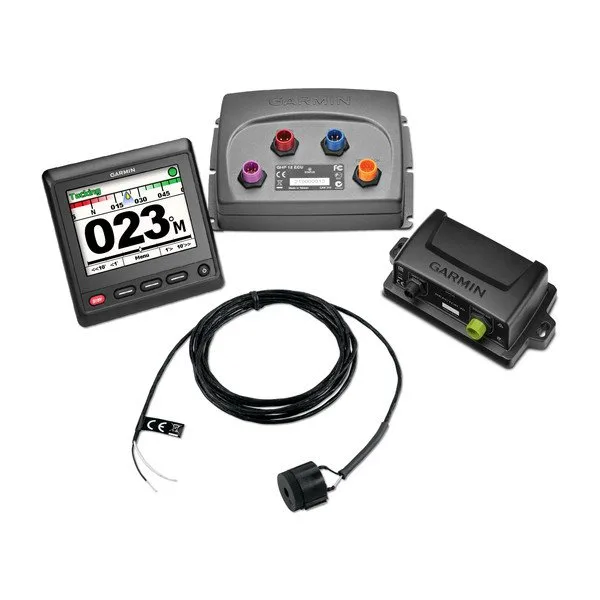
B&G (Simrad) NAC-3 Core Pack and Compass
This kit includes the main computer for the Simrad family of autopilots. You can couple this with any type of drive unit. All controls for the autopilot are accomplished through the B&G Zeus or Vulcan multi-function display. If you want a dedicated control panel, they sell that as well. You may also need a rudder position sensor to make the system work.

Furuno NAVPILOT300
This is an all-in-one solution that requires fewer parts. You’ll still need a drive unit and a heading sensor to make a complete system.

Top Brands of Sailboat Auto Pilot
As mentioned above, the big names in sailboat instruments all offer autopilot packages. If you’re only replacing the autopilot electronics, keeping everything the same brand makes sense. However, if you’re replacing everything, you have bigger choices to make.
Garmin applies the lessons they learned by making several generations of aircraft autopilots. Their systems integrate much more than a simple flux-gate compass–their autopilots are built with a full-fledged AHRS (Attitude Heading Reference System).
Using this Autopilot Compatibility Guide , you can figure out which Garmin autopilot is right for you.
Navco is the parent company of three different electronics brands–B&G, Simrad, and Lowrance. That’s a perk because you can mix and match components between the three names at will. B&G is the favored brand for sailboats. The B&G NAC-2 and NAC-3 autopilot computers are the basic start for the typical cruising yacht. High-end racers and luxury boats will want to look into the fancier H5000 autopilot system.
Simrad sells a line of basic tiller pilots for above-deck autopilot installs on small boats.
Raymarine is one of the older and most trusted brands in marine electronics. Their autopilots are robust and come in any arrangement you like. In addition, they have one of the only above-deck wheel-drive autopilot systems on the market, the EV-100 SAIL. They also have tiller pilots and a complete lineup of below-deck options.
Furuno is an underdog in the recreational marine industry – favored by professionals but often overlooked by the private boat owner. Their autopilot NAVPILOT offerings are adaptive controllers designed to make boat handling easier. Most are designed for outboard hydraulic-steer fishing boats, but their control heads and computers will work with almost any type of setup.
How much does a sailboat autopilot cost?
The cost and complexity of an autopilot system depend on the size of the boat. Small tiller-steered daysailors can usually at a tiller pilot for less than $1000.
A below-deck autopilot, with all of the components to make it work with your multi-function display, will set most owners back $4,000 or $6,000. In addition, if the boat does not already have a below-deck autopilot, there may be quite a bit of labor necessary to build platforms or brackets to adapt the drive unit to the rudder post.
Do sailing yachts have autopilot?
Yes, most sailboats larger than daysailers have autopilots. These vary in complexity from mechanical windvanes to extensive electronic systems that tie into the boat’s GPS and multi-function displays.
Can you sleep while your boat is on autopilot?
A good autopilot will steer a boat for you, on a constant heading or wind angle, through nearly any conditions. However, it cannot ensure that you don’t hit anything–like another vessel. It is illegal to operate a vessel without a “proper look-out by sight and hearing as well as by all available means appropriate…to make a full appraisal of the situation and or the risk of collision” (COLREGS Rule 5).
Matt has been boating around Florida for over 25 years in everything from small powerboats to large cruising catamarans. He currently lives aboard a 38-foot Cabo Rico sailboat with his wife Lucy and adventure dog Chelsea. Together, they cruise between winters in The Bahamas and summers in the Chesapeake Bay.
Leave a comment
Your email address will not be published. Required fields are marked *
Save my name, email, and website in this browser for the next time I comment.
- Hiking Shoes
- Hiking Boots
- Hiking Sandals
- Trail Runners
- Base layers
- Hiking Shirts
- Fleece Jackets
- Softshell Jackets
- Rain jackets
- Down Jackets
- Hiking Pants
- Hiking Shorts
- Base Layers
- Rain Jackets
- Hiking Bras
- Baby Carriers
- Cookware Sets
- Water Filters
- Water Purifiers
- Sleeping Bags
- Sleeping Pads
- Hiking Poles
- GPS Devices
- Solar Chargers
- Dive Regulators
- Dive Computers
- Dive Watches
- Dive Wetsuits
- Dive Gloves
- Dive Lights
- Dive Knives
- Spearfishing Wetsuits
- Spearfishing Masks
- Spearfishing Fins
- Spearfishing Watches
- Freediving Wetsuits
- Freediving Masks
- Freediving Fins
- Freediving Watches
- Sit On Top Kayaks
- Inflatable Kayaks
- Fishing Kayaks
- Tandem Kayaks
- Touring Kayaks
- Kayak Paddles
- Kayak Seats
- Kayak Roof Racks
- Kayak Carts
- Stand Up Paddle Boards
- Touring SUPs
- Inflatable SUPs
- Fishing SUPs
- SUPs For Yoga
- SUPs For Surfing
- SUP Paddles
- Climbing Boots
- Belay Devices
- Climbing Shoes
- Women's Climbing Shoes
- Bouldering Shoes
- Approach Shoes
- Climbing Pants
- Bouldering Pants
- Mountain Bikes for Men
- Mountain Bikes for Women
- MTB Handlebars
- Bike Saddles
- Bike Computers
- Bike Lights
- MTB Jackets
- Bike Helmets
- Bike Packing Gear
- Fat Biking Gear
- Ski Bindings
- Ski Helmets
- Ski Goggles
- Ski Jackets
- Snowboarding Bindings
- Snowboarding Boots
- Snowboard Helmets
- Snowboard Goggles
- Snowboard Pants
- Snowboard Jackets
- Snowshoe Poles
- Avalanche Beacons
- Avalanche Probes
- Avalanche Shovels
- Ski Backpacks
- Surfboards For Beginners
- Surfboards For Kids
- Surfboard For Small Waves
- Soft Top Surfboards
- Foam Surfboards
- Body Boards
- Boogie Boards
- Kiteboarding Kites
- Kitesurfing Boards
- Kiteboarding Harnesses
- Surfing Wetsuits
- Men's Rash Guards
- Women's Rash Guards
- Board Leashes
- DLSR Travel Cameras
- Mirrorles Travel Cameras
- Point and Shoot Travel Cameras
- Fuji Travel Lenses
- Nikon Travel Lenses
- Tripods for Travel
- DLSR Landscape Cameras
- Mirrorles Landscape Cameras
- Point and Shoot Landscape Cameras
- Fuji Landscape Lenses
- Nikon Landcape Lenses
- Canon Landcape Lenses
- Tripods for Landscape Photo
- Wildlife Cameras
- Wildlife Lenses
- Wildlife Tripods
- Wildlife Monopods
- Birdlife Cameras
- Birdlife Lenses
- Surfboards For Small Waves
Best Autopilot For Sailboats of 2024
Unless you plan on growing multiple limbs or you have a large, regular sailing crew, then it’s inevitable that at some point you’ll need an autopilot to help you stay on course while you adjust the sails or grab something from below deck. Autopilots are useful for both the day sailors that enjoy exploring their home harbors and waters and for cruisers who plan on sailing at night and for weeks on end. Whether you have a tiller-steered sailboat or a mechanically-steered boat, there’s an autopilot that will work for you and your vessel. We’ve put together a guide to help you find the best autopilot for sailboats and for the type of excursions that you enjoy. Take a look, and see you out there, sailor!
For more of our top sailing gear recommendations, check out the Best Marine GPS Chartplotters .
Quick Answer - The Best Autopilot For Sailboats
- Raymarine ST1000 Plus Tiller Pilot View at Amazon
- Simrad TP10 Tillerpilot View at Amazon
- Raymarine M81131 12 Volt Type 2 Autopilot Linear Drive View at Amazon
- Garmin GHC 20 Marine Autopilot Helm Control View at Amazon
- Raymarine Evolution Ev-200 Sail Autopilot View at Amazon
Comparison Table - Best Autopilot For Sailboats
| Name | Best Use | Display Type | Warranty | Price | Rating | Review |
|---|---|---|---|---|---|---|
| Tiller-steered Sailboats | Backlit LCD | 2 years | $ | 4.9 | ||
| Tiller-steered Sailboats | N/A | N/A | $ | 4.85 | ||
| Mechanically-steered Sailboats | N/A | 2 years | $$$ | 4.8 | ||
| Power & Sailboats under 40 feet in length | Glass-Bonded, Anti-Glare Color TFT Lens | 2-year limited (Owner Installed); 2-year parts and onboard (Certified Installer) | $$ | 4.6 | ||
| Mid-Size Mechanically-Steered Sailboats | Backlit LCD | 2 years; 3 years with product registration | $$$ | 4.75 | ||
| Name | Best Use | Display Type | Warranty | Price | Rating | Review |
Reviews - Best Sailboat Autopilot
Raymarine st1000 plus tiller pilot.
- Best Use : Tiller-steered Sailboats
- Warranty : 2 years
- Display Type : Backlit LCD
- Voltage : 10-16V DC
- Thrust : 125 lbs.
- Data Interface : SeaTalk, NMEA 0183
- Max. Recommended Displacement : 6,000 lbs.
- Improved Waterproofing Ensures That You’ll Be Able To Use This Autopilot In Calm Seas And Stormy Weather
- Intelligent Software Minimizes Draw On The Battery For Longer Battery Life
- Simple Six-Button Keypad Makes It Easy To Use This Autopilot
BEST FOR: AFFORDABLE PERFORMANCE
This classic tiller autopilot is the perfect accessory for your day sailing vessel. The ST1000 can accept NMEA data with its intelligent software for accurate navigation to a waypoint. The backlit LCD display shows you your locked course and navigational data and information, even in the evening or low-light conditions. This autopilot also has an AutoTack feature, which will tack the boat for you while you adjust and handle the sheets and sails. Finally, the autopilot comes with everything you’ll need to install and use your device, including mounting socket, tiller pilot socket, gasket, cable clip, and clamp, among other items.
Simrad TP10 Tillerpilot
- Warranty : N/A
- Display Type : N/A
- Voltage : 12V DC
- Thrust : 143 lbs.
- Data Interface : N/A
- Max. Recommended Displacement : 10,000 lbs.
- Precision Steering In A Variety Of Weather And Water Conditions
- Runs Very Quietly So That You Can Enjoy The Natural Sounds Of The Water
- Waterproof Sealing Protects Against Spray And The Elements
BEST FOR: SAILBOATS UP TO 32’ IN LENGTH
If your sailboat is tiller-steered and 32 feet or less in length, than this Simrad TP10 TillerPilot is a great autopilot option for you. The combination of the advanced software in this autopilot with its simple, five-key display and controls make this device really user-friendly and effective in all types of weather conditions. This autopilot also includes battery use optimization with a low-power draw so that your battery lasts longer, even with prolonged use. Finally, this autopilot is designed with the sailor in mind. It runs extremely quietly so that you can truly get away from it all and enjoy your time on the water without whirring and interruption from the autopilot.
Raymarine M81131 12 Volt Type 2 Autopilot Linear Drive
- Type : Linear Drive unit
- Best Use : Mechanically-steered Sailboats
- Voltage : N/A
- Data Interface : SeaTalk, NMEA 2000
- Max. Recommended Displacement : 33,000 lbs.
- High Performance With Minimal Electric Current Consumption
- Quiet Operation For Optimal Sailing Experience Without Extra Machine Noises Interrupting Your Peace And Quiet
- Two Year Warranty For Added Security
BEST FOR: SEASONAL CRUISERS
Do you spend your winters cruising south towards Florida or the Carribean? If so, the Raymarine M81131 12 Volt Type 2 Autopilot Linear Drive might be right for you and your vessel. This autopilot is designed for sailboats with existing mechanical steering systems; if your vessel is large enough to have a full motor system, then you’ll want this type of autopilot with a powerful thrust and an electromagnetic fail-safe clutch. Finally, this system works in coordination with SeaTalk and NMEA 2000 navigation data so that you can count on precision navigation from your home port to a waypoint.
Garmin GHC 20 Marine Autopilot Helm Control
- Best Use : Power & Sailboats under 40 feet in length
- Warranty : 2-year limited (Owner Installed); 2-year parts and onboard (Certified Installer)
- Display Type : Glass-Bonded, Anti-Glare Color TFT Lens
- Voltage : 9-32V DC
- Thrust : N/A
- Data Interface : NMEA 2K
- Max. Recommended Displacement : Best for Power & Sailboats under 40 feet in length
- Bright Four Inch Display With Glass-Bonded, Anti-Glare Lens For Optimal Viewing
- Daylight Readability Is Enhanced By High-Contrast Color Scheme
- Compatible With Quatix Marine Watch And Other Garmin Products
BEST FOR: OVERNIGHT EXCURSIONS
If you’re headed out on a multi-day excursion which might require some overnight cruising, you’re going to need an autopilot with a display that you can read well in low light conditions and at nighttime. This Garmin GHC 20 Marine Autopilot Helm Control is the perfect product for that type of an adventure.
Its four inch display with enhanced nighttime readability and glass-bonded, anti-glare lens to prevent fogging and glare in sunny conditions will help you maintain control in all types of conditions, at all times of day. It also has a 170 degree viewing angle, so whether you’re up on deck adjusting the sails or below deck grabbing an extra sheet, you’ll be able to glance over at the display and see what’s going on. This autopilot also works for both power and sailing vessels. Finally, its five-button control is easy to use, so you’ll be off on your sailing adventure before you know it.
Raymarine Evolution Ev-200 Sail Autopilot
- Best Use : Mid-Size Mechanically-Steered Sailboats
- Warranty : 2 years; 3 years with product registration
- Thrust : 650 lbs.
- Max. Recommended Displacement : 24,000 lbs.
- Contains A High Tech Sensor And Full-Function Course Computer
- Uses Artificial Intelligence Algorithms To Maximize Performance, Instead Of Manual Calibration
- EV Sensor Core (GPS Unit) Can Be Mounted Above Or Below Deck
BEST FOR: SAILBOATS WITH MECHANICAL STEERING
If you’re looking for a powerful, tech-forward autopilot with cutting edge navigation technology, then the Raymarine Evolution EV-200 Sail Autopilot might be the right one for you. Designed with sophisticated AI algorithms that perceive the environment and instantly calculate and evolve steering commands, this autopilot optimizes your cruising experience without the need for manual calibration or adjustment. The result is precise steering and course keeping, regardless of the vessel speed or sea conditions. Finally, the package includes the EV sensor core, which is similar to a marine GPS unit. It can be bracket-mounted either above or below deck, depending on space and convenience.
THINGS TO CONSIDER WHEN BUYING AUTOPILOTS FOR SAILBOATS
It’s important to consider the size of your sailboat before you purchase an autopilot. Autopilots are designed with specific thrust and power draws depending on the boat that it’s optimized for. Be sure to know the length of your boat as well as the water displacement (in pounds) so that you can choose the optimal autopilot device for you.
STEERING TYPE
Autopilots are a complicated piece of technology designed to keep you on course when you can’t be at the helm. If your sailboat is steered with a tiller, then you’ll be looking at the tiller-steered category of autopilots. If it’s mechanically steered, then you’ll be shopping for autopilots that are compatible with that type of a system. West Marine has a great resource archive for everything you need to know about sailing. Check out this informational article on selecting an autopilot for more information.
HOW YOU USE YOUR SAILBOAT
Do you like to go out for the day to explore the area around your home port or do you cruise down to the Caribbean seasonally in winter? Are you able to handle your sailboat by yourself or do you typically need a crew? These are all types of questions to ask yourself before investing in an autopilot. Consider the type of boat that you have and how you enjoy using it to choose the best sailing autopilot unit for you.
FEATURES EXPLAINED
A horizontal bar fitted to the rudder of the boat and used as a lever for steering.
This term refers to the main body of the boat, including the sides, bottom, and deck, but excluding the mast, sails, rigging, and other features.
This term refers to the way a sailboat is maneuvered. If your desired course is into the wind, the boat is turned toward the wind so that the direction from which the wind blows changes from one side to the other, thereby allowing forward progress.
The helm of the boat is the place from which the boat is steered.
The sheets refer to the ropes or lines that adjust the movable portions of the sails.
This term refers to the front end of the sailboat.
The stern is the back end of the sailboat.
The port side of the sailboat is the left side of the boat when facing forwards towards the bow (or front) of the vessel.
The starboard side of the sailboat is the right side of the boat when facing forwards towards the bow or front of the vessel.
For more of our top sailing gear recommendations, check out these popular buyer's guides:
Sailboat Anchors
Sailboat Winches
Sailing Shoes
Solar Panels for Sailboats
Bilge Pumps
- BOAT OF THE YEAR
- Newsletters
- Sailboat Reviews
- Boating Safety
- Sails and Rigging
- Maintenance
- Sailing Totem
- Sailor & Galley
- Living Aboard
- Destinations
- Gear & Electronics
- Charter Resources
- Ultimate Boating Giveaway

Modern Sailboat Autopilots
- By Dave Schmidt
- Updated: May 8, 2019
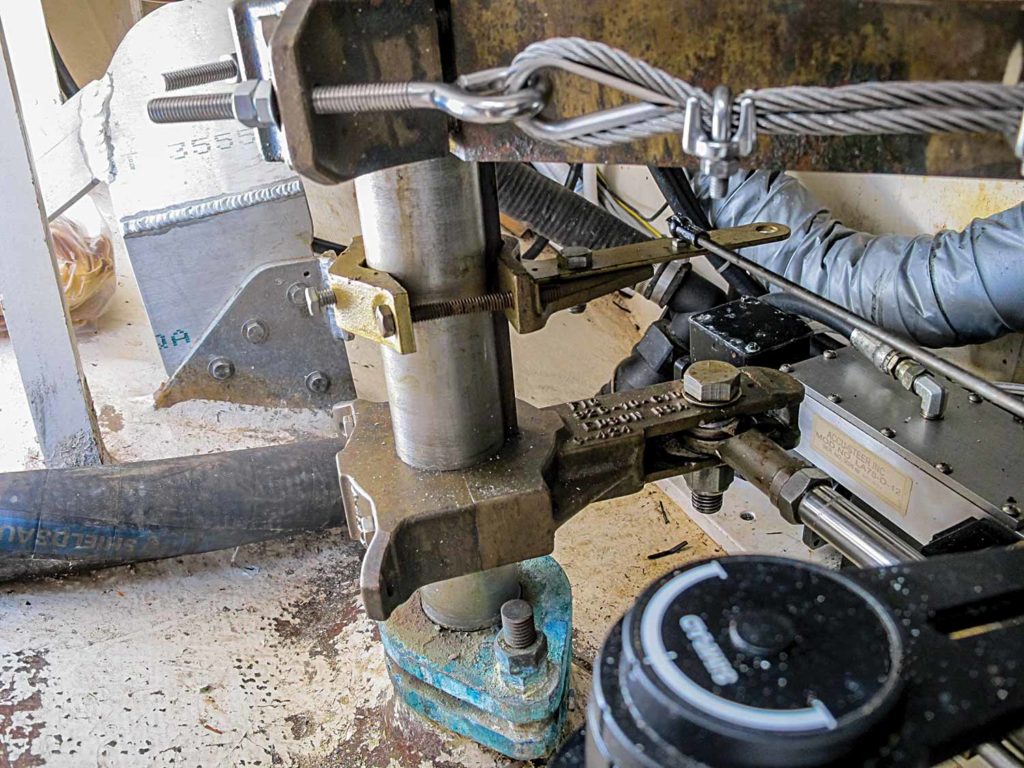
Hand steering is one of sailing’s greatest joys, but the truth is that most sailors struggle to hold an accurate course for more than 30 minutes. This is why racing crews regularly rotate drivers, and why most cruising sailors carry an autopilot that can handle helm duties when the weather turns bleak, attention deficits lurk or other onboard responsibilities take priority over chasing the compass card.
While autopilots have been steering recreational sailboats since Derek Fawcett introduced his original Autohelm in 1974, contemporary systems use solid-state components, cutting-edge processors and powerful algorithms to deliver significantly better performance and advanced features to aid in getting from Point A to B. Here’s a look at what’s on the market and the important things to consider when shopping for a new electronic hand on the helm.
At their core, autopilots consist of four basic components: a black-box central processing unit (CPU), which is the system’s brains and power supply; a hydraulic or electric drive unit that delivers the brawn that physically turns the boat’s rudder; a control head, which the helmsman uses to set a course with the touch of a button; and a heading sensor, commonly a fluxgate compass. Additional bells and whistles, such as a rudder-indicator sensor, a wind-and-speed sensor, and GPS and chart plotter can also be tied into the pilot system via an NMEA 0183 or NMEA 2000 network, allowing the autopilot to access the boat’s navigation system for increased functionality (more on that later).
In its simplest application, once the autopilot’s installed, a skipper manually steers the boat onto a desired course and engages the autopilot using the control head, which is typically mounted near the helm station. Course adjustments are typically made in increments of 1 and 10 degrees, either via hard-key buttons on the control head, a handheld remote control or an app.
When engaged, the autopilot relies on external sensors and internal algorithms to apply the least amount of rudder movement to maintain course. No matter who’s driving, excessive rudder movement directly equates to drag. While autopilots don’t fatigue in big waves the way a sailor might, they do consume more juice when they’re working hard, so autopilot manufacturers develop software controls to properly hold course without sapping boat speed or draining the batteries.
One of the most critical decisions when choosing an autopilot is ensuring that the drive unit is properly sized for the boat. “It’s all based on the boat’s displacement,” says Jim McGowan, Raymarine’s Americas’ marketing manager. When selecting a drive, he advises, “You want to use the boat’s dry weight and then add 20 percent to account for fuel, people and their gear.”
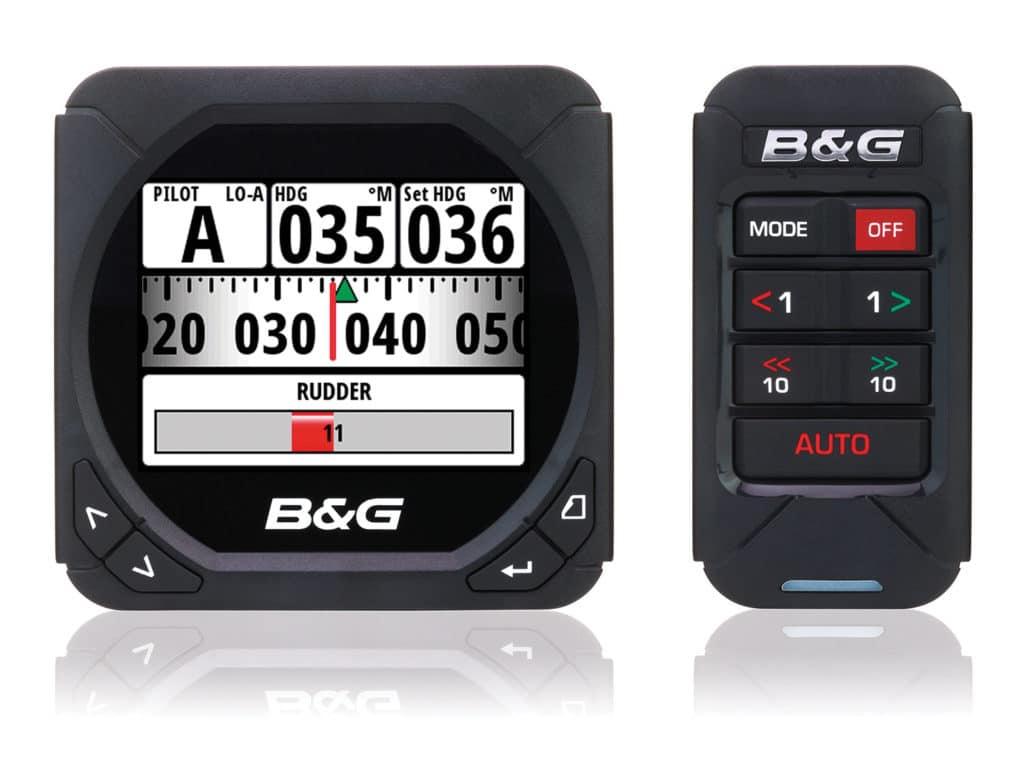
Autopilot drives are typically designed to work up to a certain weight, and it’s important to both performance and safety that this is properly matched as this in turn will dictate the system’s power requirements. Most sailboat-friendly autopilots draw between 2 and 7.5 amps, depending on the size of the CPU required by the system. While the CPUs in a given model range will typically employ identical algorithms, the bigger CPUs deliver more power to their drives.
When buying an autopilot system, be sure your vessel falls well within the designed working range. “When you fall on the line, you always want to go up,” advises McGowan. “It requires a lot of torque to drive the rudder arm in big seas, and if the pilot is up against its limit, there’s a lot more stress on the equipment and more heat buildup in the control unit.”
Matt Fries, B&G’s business acquisition manager, advises that customers should also take into account the design and sailing characteristics of their boat when selecting a drive. “A 40-footer with a full keel and an aft-hung barn-door rudder might require a more powerful drive than a 50-footer of the same displacement that has a more balanced rig/keel configuration and a more modern rudder design,” he says. “It’s more important that the drive suits the boat than who makes it. If [a boat’s] existing drive works and is proven, we’re fine using it.” This same drive-system agnosticism exists amongst most manufacturers and potentially opens the door to cost-effective modular autopilot upgrades, as most modern autopilots can be matched up to power and control different drive types.
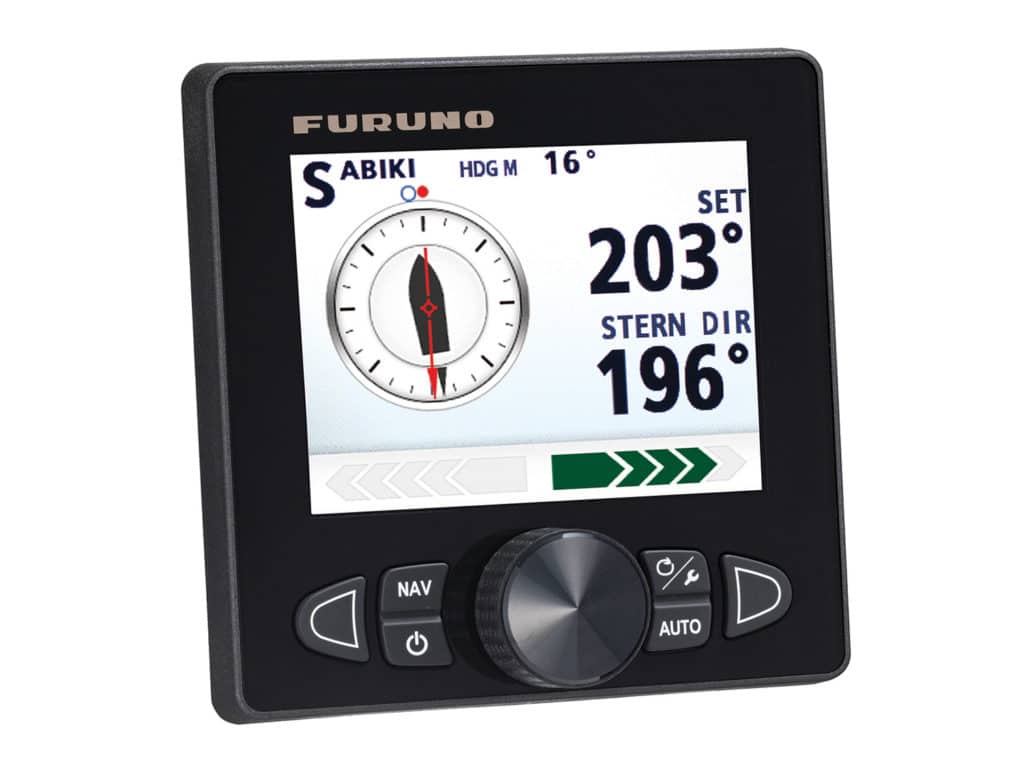
As with all electromechanical systems, the course that the autopilot steers is only as accurate as the input of its sensors — in this case, the most critical data is the vessel’s compass course. While fluxgate compasses provide accurate azimuth information, their reporting rates of 1-10 hertz are sluggish to report course changes compared to today’s nine-axis compasses, which feature updated rates in the ballpark of 10-30 hertz, or that number of times per second. Moreover, the new breed of compasses are accurate to roughly plus or minus 2 degrees magnetic, and also deliver pitch, roll and yaw information, and in some systems, even heel angle. All this data means the autopilot’s CPU and algorithms can more efficiently stay on course. When networked with other onboard devices, the data can also account for vessel motion and the affect it has on wind angle and speed data. As a result, nine-axis compasses have largely usurped fluxgate compasses.
“The EV1 is the system’s decision maker,” says McGowan, describing the role of the solid-state attitude heading reference system (AHRS) that’s central to Raymarine’s Evolution autopilot system. “All smarts are in there, and it sends its command signals to the control head and the drive.” The system is upgradeable, allowing Raymarine to push new features out to existing Evolution autopilots.
While nine-axis compasses have become the industry standard for autopilot heading sensors, even more precise options exist. “Furuno pilots interface really nicely with our SC33 satellite compass,” says Eric Kunz, Furuno’s senior product manager. And, he notes, the cost for these sophisticated compasses has been dropping. “It delivers roll, pitch and heave information, and it’s accurate to .5 degrees, which allows the system to steer a straighter course.”
As previously mentioned, modern autopilots are typically NMEA 0183 or NMEA 2000 compatible, allowing their information to be displayed and sometimes controlled via the vessel’s chart plotter. “One thing that’s changed dramatically is that you used to need a dedicated control head, but now plotters can control this,” says McGowan. In other words, Raymarine chart plotters can control the company’s Evolution autopilots. While this capability exists across all brands, not everyone is sold on chart-plotter control alone.
“I wouldn’t go to sea with just a chart plotter controlling the autopilot,” says Kunz, citing safety risks. “With our NAVpilot-711C, you need a connection between the processor and the control head and the heading sensor.” Up to six control heads can be added to the system.
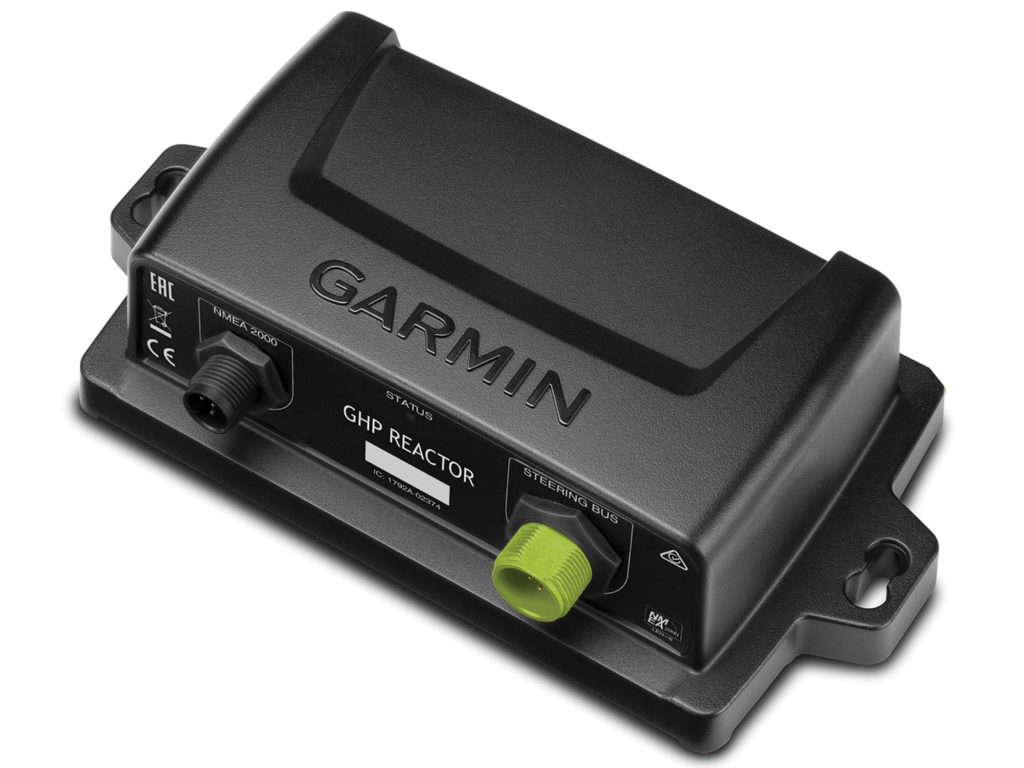
Irrespective of what interface a boat owner employs, today’s autopilot systems offer new capabilities and sailing-specific features. Perhaps most publicized is their ability to auto-calibrate and adapt to a vessels particular motion underway.
“Before our Evolution autopilots, it took a lot of work to get a [Raymarine] autopilot set up and calibrated,” says McGowan. “You had to spin circles so that the autopilot could figure out the boat’s magnetic deviation.” By contrast, Evolution pilots automatically “learn” the boat’s turning characteristics over time. They work right out of the box, and their AHRS sensors are so sensitive that they can calculate what’s happening on the boat in real time.
While this is great for anyone who hates owner’s manuals, not all experts are ready to trust in technology alone.
“All autopilots should be properly commissioned and sea-trialed to ensure proper steering performance before being put into service,” says Fries. While B&G’s pilots support auto-calibrating and self-learning capabilities, there’s useful information that’s best gleaned the old-fashioned way. “After swinging the compass, the system gives you a field percent score, which shows the ratio of the boat’s local magnetic field to the earth’s magnetic field. I like to see less than 15 percent.” (See “Smartphone Detection,” below)
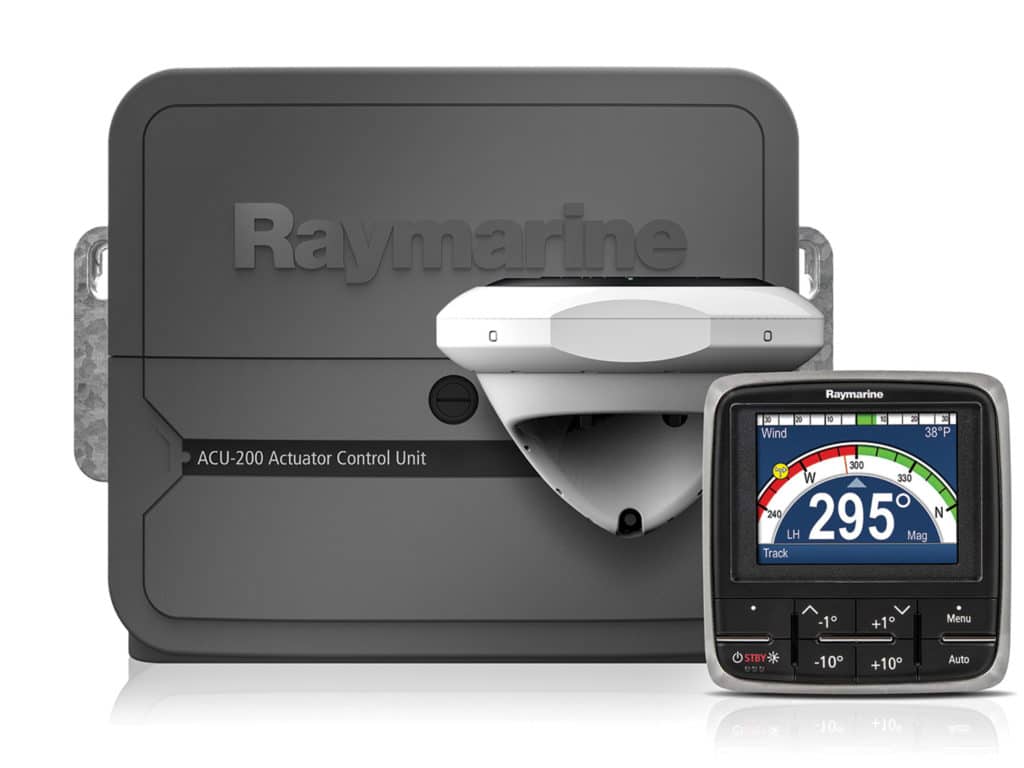
Once set up and calibration is complete, users can dial in the amount of acceptable cross-track error when underway. Furuno, for example, offers two different driving modes: economy and precision. “With precision mode, we’re trying to keep the boat right on the cross-track line,” says Kunz. The system essentially sets a waypoint 100 miles out and maintains a course that’s within a 6- to 10-foot accuracy zone. In economy mode, the system lets the vessel’s course drift more, so there’s less rudder movement and drag. Kunz says this is especially beneficial to bluewater sailors.
Another interesting feature involves using the vessel’s cartography and chart plotter capabilities to automatically generate a route, which is sent to the autopilot as a series of waypoints. “If you’re using a Garmin chart plotter, running Garmin’s g3 cartography and using a Garmin autopilot, the system will follow a route that was generated by auto-routing,” says Dave Dunn, Garmin’s director of sales and marketing for marine. Furuno also offers similar capabilities thanks to its ownership stake in TimeZero (née Nobeltec and MaxSea). “TimeZero can take in the boat’s polars and take into account wind [forecasts] and the best time to go,” says Kunz. Skippers using computers that run the necessary Windows-compatible software can access this same functionality using a USB gateway that connects to the autopilot’s processor.
While NMEA 0183 and NMEA 2000 compatibility between the autopilot CPU and a chart plotter or computer has in some cases eliminated the need for a dedicated control head, it has also opened the door for app-based remote control. Contemporary chart plotters are all Wi-Fi enabled and most manufacturers, including Garmin and Furuno, build smart-device apps that deliver wireless plotter control, and therefore autopilot control. For the record, B&G and Raymarine do not allow this functionality for safety reasons.
In addition, Garmin allows users to control their autopilots via a quatix 5 watch and the company’s new Reactor Autopilot Remote controller, which features gesture control (see “Mind Control,” left). “You just point it to a heading, and the boat will sail the course,” says Dunn. As of now, Garmin is the only manufacturer to offer a gesture-sensitive control for a sailboat-compatible system, however Furuno makes a similar remote control for its powerboat-specific NAVpilot 300.
Recent years have also seen the advent of newer sailing-specific software features such as B&G’s ability to steer to specific wind angles. “If you engage the pilot’s wind mode, it will steer apparent wind angles, and downwind it will steer true wind angles,” says Fries. “The idea is that it’s easy to sail to the telltales upwind, but when you’re sailing downwind in seas, true wind angle is more stable and can avoid a crash gybe.”
McGowan says Raymarine has updated the Evolution’s ability to steer a course using a windvane as well, and it has also improved the system’s ability to perform automatic tacks when sailing to weather without overstanding its new course.
Finally, modern autopilots usually offer some sort of man-overboard mode, be it prescripted driving patterns or the ability to hold the bow in irons.
NKE takes this a step further with its system-agnostic Crew Transmitter, which establishes an electronic link with your nav system that’s broken if a user-worn pendant travels more than a certain distance away. Should this happen, the nav system drops a pin and triggers onboard MOB alarms. Using NKE’s Gyropilot remote control system, if an NKE autopilot is engaged at the time of the crew-overboard incident, it will either turn the boat into the wind or, if there’s no networked wind sensor, put the helm hard over.
Given the increased functionality, features and performance of modern autopilots, there’s little reason to suffer long stints at the wheel unless, of course, you feel like steering just for the fun of it.
David Schmidt is CW_’s electronics editor_.
Autopilot Manufacturers
- B&G : 603-324-2042; from $2,300.
- Furuno : 360-834-9300, from $3,400.
- Garmin : 800-800-1020, from $2,000.
- NKE Marine Electronics : from $5,400.
- Raymarine : 603-324-7900, from $2,000.
Smartphone Detection
Magnetic interference is a time-honored autopilot headache and can be triggered when equipment is loaded aboard or new systems are added. While properly installed, self-learning autopilots will eventually detect — and correct for — this interference, a smarter and more immediate tip, says B&G’s Matt Fries, involves using an app. “Everyone has a smartphone, and there are [deviation-sensing] apps that measure the boat’s magnetic field,” says Fries. “An owner might not realize that there’s an [outboard] motor behind a bulkhead.”
If there’s a magnetic-interference issue at play, this trick, coupled with the field-angle percentage that’s generated when swinging the boat and autopilot compass, should reveal the culprit.
Mind Control
An 8- to 10-knot southerly blew across Seattle’s Portage Bay as John Tenneson, owner of the nicely appointed J/145 Jedi , handed me Garmin’s new gesture-enabled Reactor Autopilot Remote controller, which was wirelessly tethered to Jedi’s Garmin autopilot. I aimed the controller 10 or 15 degrees off the port bow, pressed a button and Jedi immediately responded. Next, I made a slower turn to starboard, followed by a few dozen more maneuvers, executed simply by gesturing and pressing.
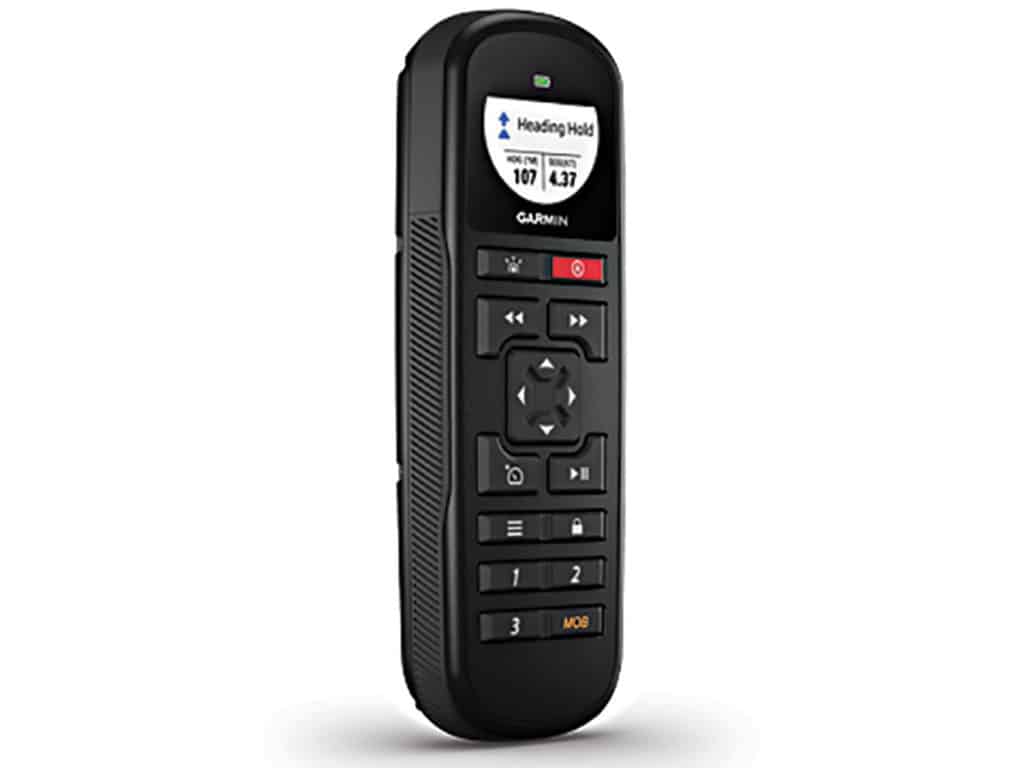
The remote also handles industry standard 1- and 10-degree course correcting commands and features three user-programmable hot keys, a dedicated MOB button and the ability to initiate auto tacks, based on apparent wind angles. The auto tack feature is especially helpful for shorthanded upwind work.
- More: autopilots , Gear
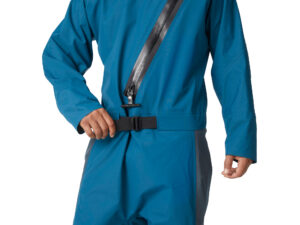
Mustang Survival’s Quadra Dry Suit
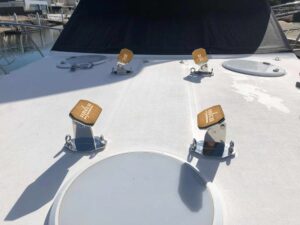
AquaChocks: Secure Tender Storage, Simplified
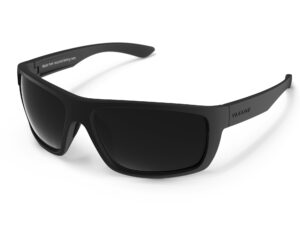
Pro-Grade Sailing Eyewear
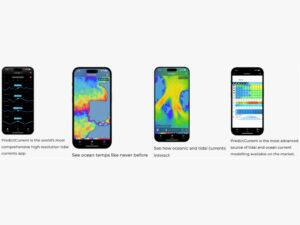
PredictWind Introduces PredictCurrent App
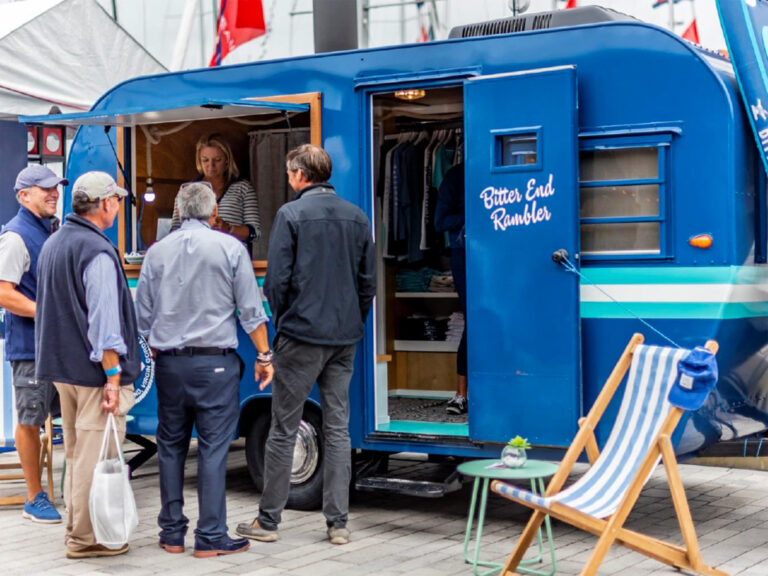
Point Your Compass Due South, Bitter End Yacht Club Reopens October 23rd.
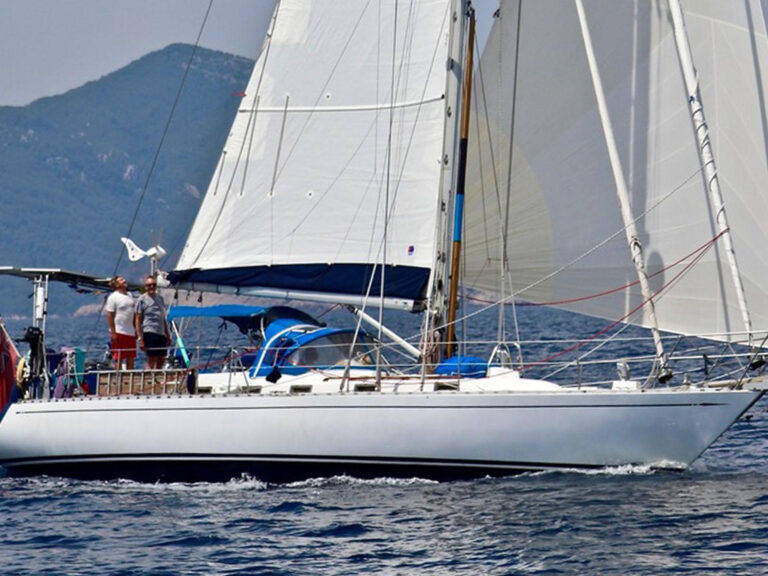
Pre-Owned: 1988 Hylas 47
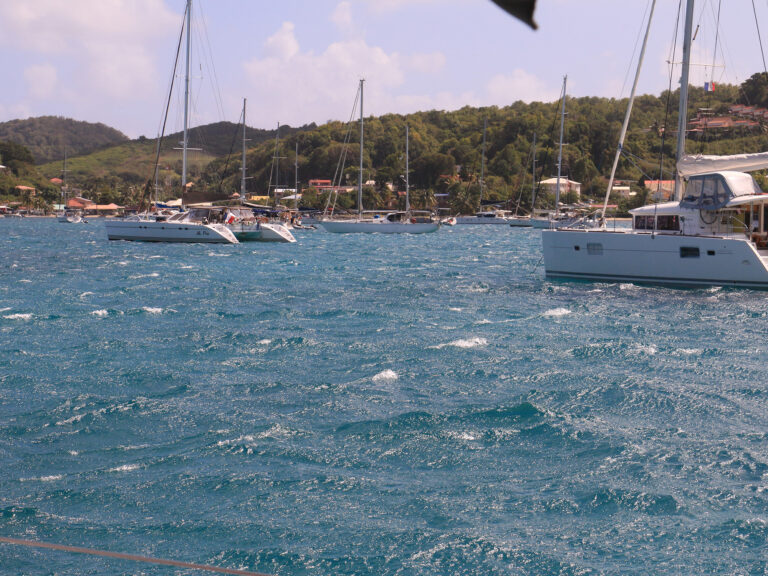
Understanding Wind in the West Indies
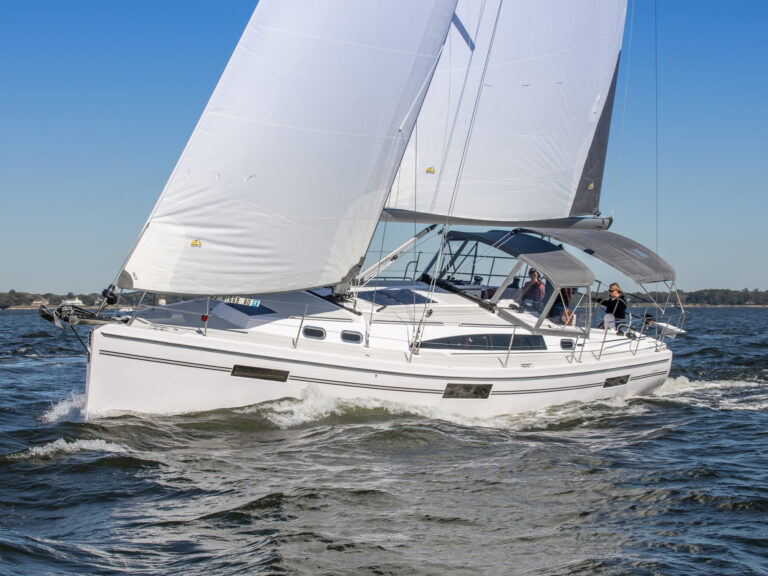
Catalina Introduces the 6 Series
- Digital Edition
- Customer Service
- Privacy Policy
- Terms of Use
- Email Newsletters
- Cruising World
- Sailing World
- Salt Water Sportsman
- Sport Fishing
- Wakeboarding
- Yachting World
- Digital Edition

What’s the best autopilot kit for a transatlantic?
- August 4, 2023
Over 250 transatlantic skippers from the most recent ARC fleet report back on the efficacy and reliability of their self-steering and self-sufficiency equipment

Few cruising skippers would argue with ocean sailing guru and founder of the Atlantic Rally for Cruisers (ARC) Jimmy Cornell when he says some form of self-steering is ‘essential for any boat that is going to be sailing offshore for any length of time’. Yet there is no requirement from World Cruising Club (WCC) for yachts participating in any of their ocean rallies to have any system at all installed.
Either way – essential or not – anyone who has endured a long enforced watch at the wheel of a yacht will testify that while steering a course can be a pleasure, being unable to leave the helm can also be a nightmare at sea.
More than 250 vessels took part in the most recent series of WCC rallies across the Atlantic – 142 entered the 2,700-mile ARC from Gran Canaria to St Lucia; 92 entered ARC Plus from to Grenada via the Cape Verdes Islands, and 30 entered ARC January, which is the same route as the November ARC.
The questions we asked each of these crews focussed on self-steering and we also asked for each skipper’s three top self-sufficiency tips. We wanted to know which was the most popular self-steering method, how the equipment performed, what went wrong and what the top tips are for successful self-steering at sea.

If a self-steering system needs to pilot your yacht for thousands of miles do you choose electronic, windvane or both? Photo: Oyster Yachts
Autopilot vs windvane
Of the 230 complete responses to the questionnaire (out of a total of 251 yachts that finished one of the three separate events) there were five yachts that sailed without any form of self-steering. Other than them, every yacht had an electronic autopilot fitted – no-one that we know of sailed with windvane only, although 33 yachts had windvane systems fitted as well as autopilots, and some windvanes were in fact used as the primary system. Monohulls make up the majority of yachts fitted with windvane self-steering, but there were two catamarans using them (out of 65 multihulls overall) as well.

Windvanes are still a popular option for some, though mostly used as a back up. Photo: ARC2022
Electronic autopilots are obviously now the dominant technology in self-steering and the most modern refinements, such as the 9-axis sensor, sailing specific algorithms and the powerful remote controls, have improved usability over the last decade.
The average boat in the fleet is around 15 years old, while the average electronic autopilot installation is half that age. While there’s no denying that there’s still a place for vintage kit – some were using pilots from Raytheon dating back 30 years – it’s worth mentioning that the questionnaire results do indicate that the older the boat, the lower the rating given to the self-steering gear (even though not all older boats carry old autopilots!).
Even the smallest vessel in the fleet, the 9.75m long catamaran Ciel Bleu , used a tiller pilot while the smallest monohull, Canadian flagged Venturi I , relied solely on a Raymarine pilot.
The next biggest yacht, 1980 Hallberg-Rassy 352 Petoya Too , had both a windvane and an autopilot fitted. Petoya Too ’s German skipper Thomas Klemens recorded using his boat’s 10-year-old Raymarine ST1001 wheelpilot for one hour a day and the two-year-old Hydrovane windvane for 23 hours per day.
Performance reviews
There are now three main suppliers for autopilot equipment in the ARC fleet: Raymarine, B&G and Garmin. Just under 55% of respondents used Raymarine control units and a further 34% used B&G. Furthermore the split between Raymarine and B&G was almost identical for the choice of course computers. Garmin was the third most popular option with 6% or 15 boats using their products.
The pumps/drives were evenly split: one third hydraulic; one third linear and the remaining third split between wheel, rotary and tiller drives (in that order).
Sixty-seven skippers rated their autopilot control unit/head/display 5 out of 5, while 112 rated theirs 4 out of 5. That’s 80% of autopilot respondents. And in a related finding from the survey: 156 (63%) rated their yachts’ course/drive computer at 4 out of 5 or 5 out of 5. This can only be interpreted as a huge vote of confidence in autopilot technology.
Seventy-five boats reported problems with their autopilots, 56 of which were encountered on the ocean crossing (rather than the ‘shakedown’ sail to Las Palmas from mainland Europe). Digging into the details of those problems reveals that skippers demand perfection but will still cede control to the unit even if performance levels drop significantly.
Drive unit problems made up 45% of the issues encountered – that’s 25 drive units across the fleet that were deemed unsatisfactory by over 250 transatlantic skippers. Just over 20% of problems were traced back to the course computer or the control unit, which leaves 30% (approximately) of problems in the ‘don’t know category’.

Photo: SV Bluewater Mooney/ARC2022
Problems and solutions
Many skippers gave their self-steering equipment quite high ratings and then went on to raise multiple issues with the overall performance or installation or reliability of their set-ups. It makes for an interesting read, and leads us to conclude that for most skippers even a poorly functioning self-steering system is better than nothing.
We discovered multiple references to autopilots as people, or crewmembers with foibles and idiosyncrasies: The skipper of Amandla Kulu advises feeding the autopilot coffee and biscuits, while the German skipper of Petoya Too described his Hydrovane as: ‘a full crew who needs no food – happy with it all the time.’
Not all windvane systems were quite so highly rated. The skipper of Malouine made a positive report on the yacht’s self-steering: ‘She is doing a good job, but takes a lot of energy, so we prefer using the Windpilot’ – which is typical praise of ‘free’ self-steering windvane systems over previous ARCs. They averaged eight hours per day on autopilot, stating: ‘we turned off the autopilot in squalls/strong winds so that it lasts for longer and has less wear and tear.’
They relied instead on a 30+ year old Windpilot for up to 10 hours per day, but even that wasn’t smooth sailing all the time: ‘Working unless the wind is coming directly from behind, then she zigzags and too big waves make her steer off course.’

A reliable self-steering crewmember can make all the difference for a relaxing smooth passage. Photo: Tor Johnson
The 2011 UK-flagged Jeanneau Sun Odyssey 45DS Optimistic was another of the belt-and-braces boats with autopilot and windvane on board. The boat’s hydraulic drive unit, computers and sensors worked perfectly for 22 hours per day on the crossing (via Cape Verdes), but the skipper reported problems with the Hydrovane instead: ‘The Hydrovane rudder broke on day two of leg one. It was repaired in Cape Verde then snapped in half on day two of leg two.’
His verdict: ‘Hydrovane did everything in their power to help me out in this situation. Their support and customer service has been very good,’ yet he concluded: the Hydrovane ‘cannot cope with big waves’. His top three tips for self-sufficiency: ‘1. conservative sail plan at night 2. good preparation 3. good tools and spares.’
Usually, windvanes take over the steering when/if autopilots fail. However there was another UK-flagged large monohull for which the opposite was true. Paul Cook, skipper of Esti , a 1996 Moody 44, was very impressed with his recently installed Raymarine ACU-400 with hydraulic ram. ‘It saved us and performed perfectly. We found the “wind vane” mode to be perfect for optimising wind shifts,’ he said. So although he didn’t need to rely on the failed windvane rudder, he pointed out that without it he’d lost his main emergency steering system.

Back up autopilot switch system on a Nautitech 46. Photo: Chet Chauhan
Autopilots aren’t without their share of faults though. South African skipper Darrol Martin took part in the ARC Plus aboard his 1988 Amel Mango . He and his crew took apart their Raymarine rotary drive unit multiple times en route to Las Palmas as well as once during the ocean passage. Despite a professional installation less than four months before the start of the event, Martin reported that the drive gears were ‘mismatched’ and the screws were too small and ‘not strong enough to hold’.
On passage to Mindelo, they made repairs using spare ring gears and planetary gears bought in Las Palmas and reported: ‘After 4th repair, it worked perfectly for 2nd half of the crossing.’ This was followed up by some further advice: ‘Get a windvane as backup. Autopilot is not robust.’
Article continues below…

How to set up your autopilot to sail faster, more comfortably and be more efficient
Pip Hare explains how setting your autopilot to suit conditions will be faster, more comfortable and more efficient

How new-age sailing autopilot systems are putting computers at the helm
A couple of decades ago I’d have recommended anyone planning an ocean crossing without a big crew to fit wind…
Thirty boats crossed the startline for the ARC January, including skipper Paolo Santagiuliana aboard his virtually brand new Neel 51 trimaran Chica 3 . The boat was fitted with the Zeus 3 chartplotter/multifunction display, which he rated 4 out of 5, but Santagiuliana found that the sensors feeding the data to his B&G drive unit via a H5000 CPU resulted in ‘very frequent ROUTE OFF’ messages. He rated the pilot’s performance as ‘very poor’ in the second half of the crossing and lamented not bringing spare sensors, but he had made provisions for such a failure by fitting a second autopilot.
‘We arrived thanks to the second one. The limit of the second one is that it cannot be fully interfaced with the B&G Zeus so you can’t automatically follow the wind, you have to manually modify the route.’ The H5000 has now been recalibrated: ‘narrowing the value of rudder gain, auto trim and counter rudder that were too large, generating a wide variation of route when the wave was more than 2-3m. I have to say that the software is much less easy for a normal sailor used to other brands.’

Photo: James Kenning/SV Falcon
Skipper Edgar Sesemann aboard 1998 Van Dam Nordia 55 Saphir af Stockholm gave middling ratings to his six-year-old Raymarine linear drive autopilot, but his secret weapon for ‘excellent’ autopilot performance?
‘I have two autopilot systems: One is the Raymarine with two mechanic linear drives that work together directly on the rudder quadrant (one pull, one push) and it makes it very strong. They both get the information from the same course computer.
‘The second autopilot is the Mamba drive that was the original autopilot on Saphir and it works by the wires to the rudder quadrant. It’s totally separated from the Raymarine system and has only compass heading. It has also been upgraded with a new separate course computer.’

eremy Snyder has both hydraulic and electric autopilot drives on his stunning Bestevaer 56ST Falcon Spirit, but had to swap out the Raymarine rudder sensor when it failed. Photo: Photos: Jeremy Snyder
Sesemann describes the value of a backup system, particularly for a double-handed yacht on long passages. ‘We got the experience in bad weather on the North Sea crossing from Inverness to Denmark. My wife was seasick and I had to hand steer for 20 hours in 5-6m waves. After that, the second autopilot was installed.’
Self-sufficiency
This year’s final question could be an article all of its own: ‘What are your three tips for keeping your yacht reliable and being self-reliant at sea?’
Klas Gunnar Johansen, skipper of 2001 Jeanneau Sun Odyssey 52.2 Blue Sunshine reported ‘two downwind sails ripped in the squalls and acceleration zones off Cape Verdes, plus the autopilot failed, as did the radar.’ The autopilot was an Autohelm ST6000 fitted in 2001 and he wrote: ‘Made a service on the unit prior to passage but it failed us on passage and we had to hand steer from day 2-12’. His top tips? ‘1. A thorough inspection before the passage 2. Three walk-arounds a day 3. A creative mindset.’
Dutch skipper Willem Henry Spek was one of several to carry both autopilot and windvane self-steering and he was glad to have the redundancy aboard.

he 2022/ early 2023 ARC crossings were relatively trouble-free for a combined total of over 250 yachts. However, Grand Soleil 54 Take Off was dismasted 1,550 miles from St Lucia. Showing impressive self-sufficiency the family crew continued on to the Caribbean under jury rig and engine. Photo: Tim Wright/photoaction.com
His venerable autopilot set-up on board his 2008 Bavaria Vision 44 included the ST6002 from Raymarine, now discontinued, which he discovered being ‘very greedy with DC power’ from the batteries due most likely to the system ‘hunting’ or over-correcting. He had to adjust rudder damping and response to reduce the power and smooth out the course when under autopilot. He also had to replace some nuts and bolts with Nyloc nuts.
The redundant unit was, it turns out, the windpilot, which he decided to dismantle because of concerns over its installation. Additional problems included the freezer not staying cold and some tears in the sails. His 3 tips for self-sufficiency: ‘1. Redundancy. 2. Know your kit so you can repair. 3. Spares and tools.’
The fleet’s smallest yacht was a British-flagged 1988 Fountaine-Pajot Maldives 32, which was driven 24 hours a day by a Raymarine ST2000 tiller pilot. Skipper Jonathan Walmsley carried two complete spare autopilots but didn’t need to use them, even when his primary pilot started behaving erratically. His top tip for tiller pilot owners is to fit a waterproof cover (including on the ram).
He also suffered starter motor failure, hence his top three tips for self-sufficiency across the Atlantic were: ‘1. Two methods of engine start 2. Complete spare autohelm 3. Know and understand all your boat’s systems’.
If you enjoyed this….
Yachting World is the world’s leading magazine for bluewater cruisers and offshore sailors. Every month we have inspirational adventures and practical features to help you realise your sailing dreams. Build your knowledge with a subscription delivered to your door. See our latest offers and save at least 30% off the cover price.
Yachting Monthly
- Digital edition

How to get the most from your boat autopilot
- Rupert Holmes
- September 29, 2021
Rupert Holmes looks at how to set up your boat autopilot so it will steer better than you can

Rupert and his partner Kass Schmitt have sailed tens of thousands of miles shorthanded or solo on 36ft zest, relying heavily on the boat autopilot. Credit: Rupert Holmes

Rupert Holmes has sailed over 80,000 miles, including from New Zealand to Uruguay via Cape Horn and racing around Britain
Installing a decent boat autopilot makes a huge contribution to comfort when cruising and passage making.
Yet for many of us the idea of being able to rely heavily on a boat autopilot in testing conditions remains a distant utopia.
However, the basic technology that enables pilots to steer accurately in challenging situations has been reasonably affordable for more than 15 years.
Equally, if your boat has an older and lower-spec system there’s often much that can be done to improve its performance.
The short-handed offshore racing community has been at the forefront of pushing development and understanding in this area for many years.
We drive our boats extremely hard, often sailing 3-5,000 miles each season, and therefore discover issues that may not otherwise come to light.
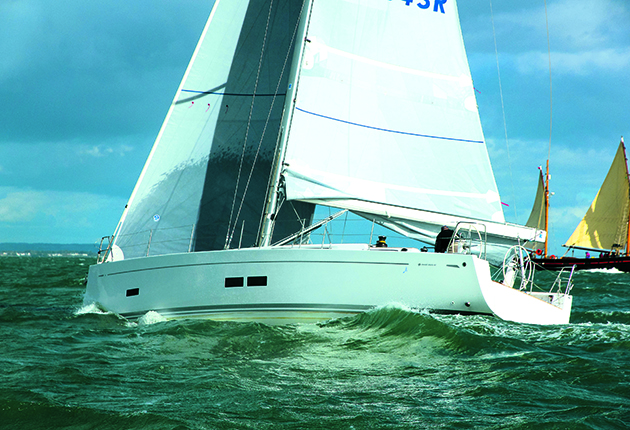
As well as getting the boat autopilot settings right, don’t forget to balance your sail plan and trim as conditions change to aid course-holding. Credit: Rupert Holmes
There are plenty of examples of very successful skippers who use their pilots almost all the time, irrespective of wind strength, wind angle, or sea state.
Among them is Pierrick Penven, whose well-travelled Jeanneau Sun Fast 3200 Zephyrin has an enviable track record.
This includes victory in the solo division of the 4,000-mile Transquadra race from St Nazaire to Martinique, which he followed with three months of family cruising in the Caribbean .
He also won both legs of the 2019 Azores and Back race, well ahead of even the best double-handed boats on corrected time.
After the AZAB Penven told me he had used the boat autopilot, ‘99.9% of the time.’
This included blasting downwind at speeds above 15 knots in 40 knot gusts in the newly formed Storm Miguel that wreaked havoc on the Atlantic coast of France a couple of days later.
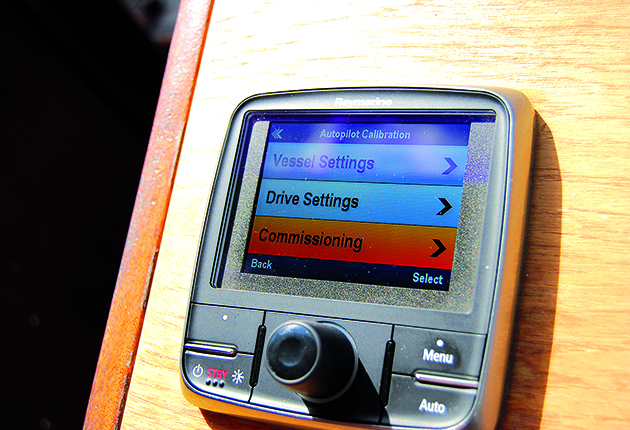
In most cases, adjusting settings for your boat autopilot requires scrolling through menus, so laminate the relevant pages of the manual as an aide memoire
Yet Penven said he only took the helm during the race ‘to have a break and a bit of fun.’ Yet his French NKE pilot, while good by the standards of many, is by no means the latest generation system.
So what’s the secret to being able to rely so heavily on a boat autopilot, even in extreme conditions?
Whatever the system, the starting point is the same: proper set up, followed by time spent learning optimal settings for different conditions.
It’s easy to think there is no need for cruisers to bother with this kind of tweaking, but that’s far from the case.
A boat autopilot that steers a more accurate course will result in a more comfortable motion in testing weather and will consume less electricity.
It’s also hugely reassuring to know your boat autopilot will cope with any conditions, whereas if someone needs to helm all the time in bad weather it quickly becomes tiring, especially with family or small crews.
Continues below…

Autopilot Buyers Guide for sailing yachts
There’s a bewildering array of options available for pilot systems, Rupert Holmes explains how to choose a suitable autopilot system…

Tech that will change your cruising
It's a bold claim that tech can change how we sail, but there are areas where marine equipment really is…
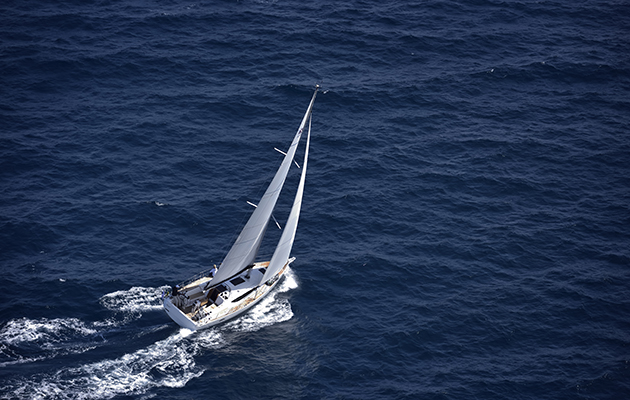
Offshore sailing skills: All you need to know
Will Bruton finds out what coastal cruisers should consider before taking their small yacht on an offshore adventure
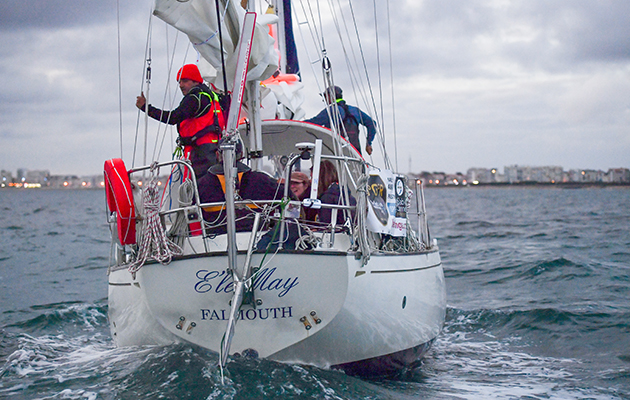
Windvane steering: why it makes sense for coastal cruising
No electricity needed and built for gale-force conditions; windvane self-steering makes sense for coastal cruisers as much as offshore voyagers.
Before he took over as CEO of the Navico marine electronics group, Volvo Ocean Race winner Knut Frostad completed an 18-month Atlantic cruise with his young family on their Outremer 5X.
While he relied heavily on his boat autopilot, the 60 or so cruisers he interviewed often told him that their pilots struggled in strong winds .
They also revealed that many owners never change their pilots from their factory settings, so the boat autopilot can’t be relied on in critical manoeuvres like reefing or in boisterous conditions.
Even the best pilots in the world can zig-zag if not set up properly, according to Frostad.
Equally, Zest , my partner’s 36ft Rob Humphreys one-off, has been steered by a mid-2000s era Simrad/B&G system for much of the 26,000 miles the boat has covered since 2013.
Although it’s a relatively simple and low-cost system by today’s standards, during that time it has coped with the full gamut of conditions, including beating under storm jib and trysail against a full gale in the Western Approaches and many thousands of miles surfing Atlantic waves at speeds well into double figures.
There’s no single magic bullet to getting the best from a boat autopilot, though several guiding principles apply almost universally.
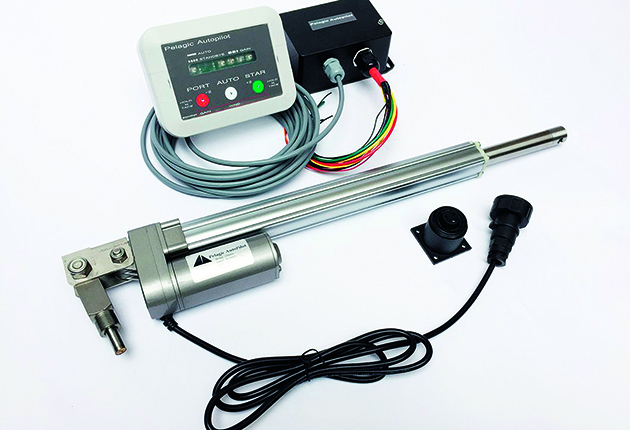
A range of brands offer boat autopilot systems including the ruggedly built Pelagic autopilot range
For a start, proper initial set up, including accurate calibration, are essential. A well-balanced sail plan and good sail trim remain as important as in the days that windvane systems were our only option for automated steering.
If the boat is set up so that a skilled human has issues keeping the boat on course, then a pilot will also struggle.
Understanding the pros and cons of different boat autopilot systems is key to being able to tweak settings and to get the best from each generation of system.
The first pilots for smaller sailing boats in the 1970s and early 1980s were impressive devices at the time.
However, they had the most rudimentary of sensors and minimal computing power, though many are still in use.
A big step forward came with the availability of reasonably affordable rate-sensing or gyro compasses. Unlike a basic fluxgate compass these can measure the rate at which a boat is turning.
The pilot computer can use this data to determine how much rudder angle is needed to correct the course – and how quickly it needs to be applied.
It’s like the difference between a novice helm attempting to steer by focussing solely on the compass and an experienced sailor who looks ahead most of the time and therefore is constantly in tune with the boat’s rate of turn.
Another important feature is the rudder angle sensor.
If the pilot knows both the rate of turn and the angle of the helm it can make a better estimate of how long to apply a course correction before moving the rudder back towards the centre.
Lack of a rudder angle sensor is a key reason why most standard tiller pilots, and externally mounted wheel pilots, can’t perform as well as a permanently mounted below-deck system.
Another leap came in the early 2010s with nine-axis sensors. These have a compass with heel, pitch and yaw sensors.
If heel angle increases, or the stern starts to lift when sailing downwind, the boat autopilot knows the boat will tend to luff up.
It therefore responds before the compass course has changed.
Elements of the boat autopilot system

- Compass or 9-axis sensor
- Optional: rudder angle sensor
- Optional: interface with other electronics, including wind data
In some cases, notably all-in-one tiller pilots, the motor, computer and compass are all contained within the single unit.
Even so, most of these units, especially more recent models, can also be networked with other elements of the boat’s electronics.
The course computer calculates exactly when, and how quickly, the rudder needs to move, as well as how much helm angle is needed.
It also figures out when to return the rudder towards a neutral position to avoid over correcting.
Gyro compasses are better than fluxgate compasses, but nine-axis sensors now measure more parameters, including heel angle, pitch and yaw that can help the course computer to calculate optimal helm movements.
In addition, if the system knows what angle the rudder is currently at, the computer can more accurately calculate how large a course correction is needed – and can apply exactly the right amount of rudder angle.
A properly calibrated rudder angle sensor is therefore an important element and markedly improves course keeping.
Properly calibrated wind data allows accurate steering when sailing close-hauled, close reaching with a Code 0 or asymmetric spinnaker , and when sailing downwind .
It’s worth noting that some autopilots and control units include proprietary software, so they need to be set up with the same brand of control unit and pilot computer, even if they are all NMEA 2000 capable.
Improving boat autopilot course-keeping
Most pilots in use today have user-adjustable parameters to improve course-keeping in different conditions.
These effectively tweak the algorithm that decides how big a rudder movement is needed to get the boat back on course and how long that helm angle can be applied without risk of over-correcting.
Sailing upwind in light airs clearly requires a different helming style to broad reaching in a stiff breeze .
This is why we need to understand how to adjust parameters like Gain, Counter Rudder and Auto Trim.
1. Understanding Gain
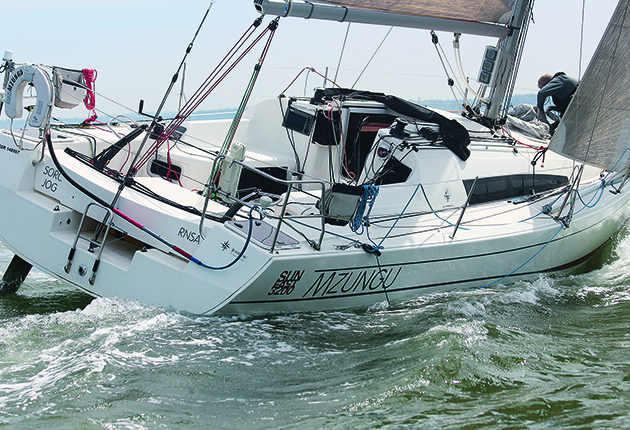
To really trust your boat autopilot, you need to know it will react appropriately for the conditions. Credit: Rupert Holmes
Gain controls the amount of rudder angle used and how quickly it’s applied. If the gain is set too low the boat will take too long to return to the desired course.
On the other hand, if gain is too high, the boat will overshoot and yaw each side of the set course.
This was a common problem with early pilots where gain was often the only parameter that could be adjusted.
2. Counter Gain
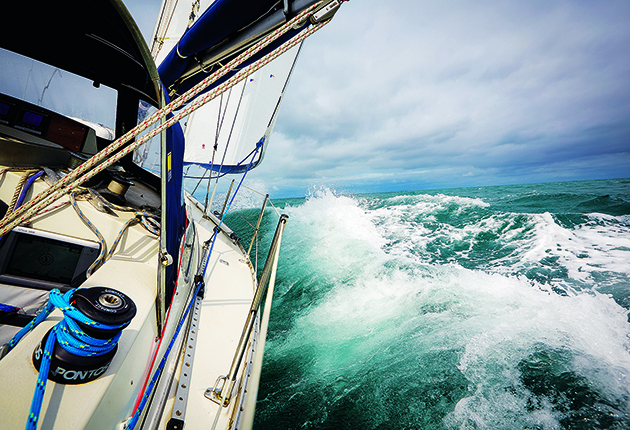
In boisterous conditions, you’ll need the boat autopilot to centre the rudder quickly after a correction. Credit: Graham Snook
The Counter Rudder (sometimes called Counter Gain) setting adjusts how long a helm correction will to be applied for.
In a quartering sea, for instance, a fast initial response is required to prevent the boat screwing up into the wind.
But then the helm needs to be centred quickly so the boat doesn’t bear away too far.
Increasing Counter Rudder does this – it doesn’t impede the initial quick movement of the rudder when gain is set relatively high, but the helm will centre more rapidly
3. Auto Trim
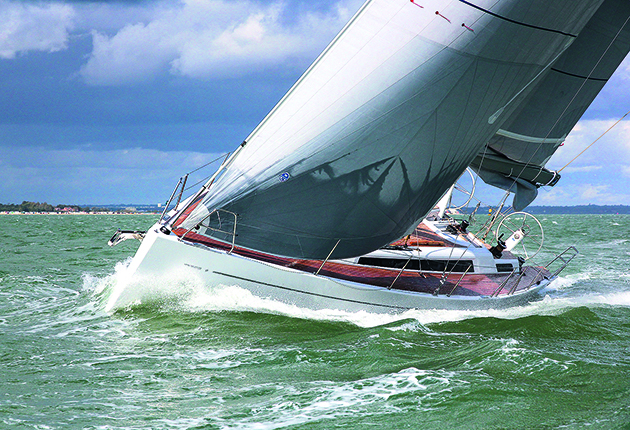
Modern pilots can learn how best to keep a boat on course. You can tell it how quickly to learn and adapt. Credit: Rupert Holmes
Auto Trim (or Auto Learn) determines the speed at which the system learns how much weather helm needs to be applied.
If the boat autopilot appears to take a long time to apply an appropriate amount of weather helm when conditions change, then a lower figure is needed.
However, if it initially oscillates between too much and too little weather helm, Auto Trim needs to be increased.
As a starting point with B&G or older Simrad systems try the vessel’s LOA in feet.
Gain is likely to account for 70-80 per cent of all adjustments needed, though Counter Rudder may need tweaking in tandem with big changes to gain.
Once you find the right Auto Trim setting for your boat it’s not likely to need a lot of adjustment.
4. Compass or wind mode?
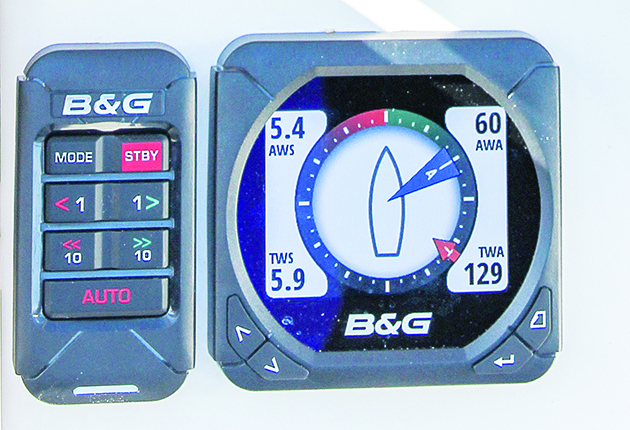
Choosing wind mode may let your boat steer more like a human helm would. Credit: Rupert Holmes
For boats with wind data interfaced to their pilots the rules for whether to use compass or wind mode depend on the point of sail.
When upwind, or close reaching with a Code 0 or asymmetric spinnaker, steering to the apparent wind angle is best.
Even then don’t expect the boat to sail as close as when you’re helming, bear away a few degrees and set the sails with a little more twist to give a wider groove.
A compass course will invariably be most efficient when reaching. Once the wind is well aft, however, changing to true wind mode will give best results.
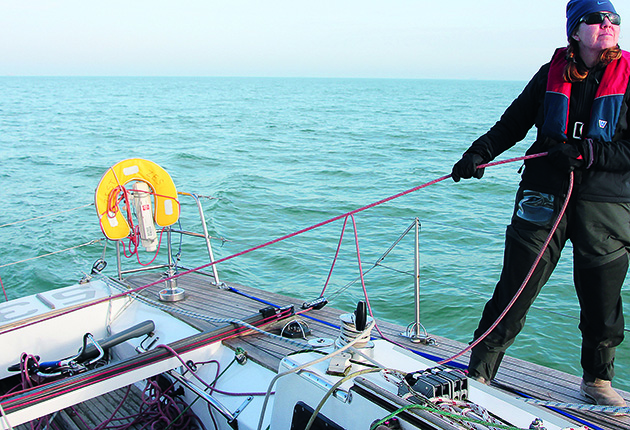
Sailing under spinnaker solo becomes enjoyable if you trust your boat autopilot. Credit: Rupert Holmes
None of the concepts required to tune a boat autopilot are intrinsically difficult when considered individually.
However, collectively they can amount to a lot to think about at times when attention may need to be focussed on other matters.
NKE has a neat solution – users enter a matrix of pre-set parameters that can subsequently be dialled in at the press of a button, much like the tuning of an old-school car radio.
The matrix covers nine different conditions: beating, reaching and running in light, medium and heavy winds. Therefore it’s easy to select the correct mode for your boat.
Successful short-handed racers will then fine-tune a little more, but for cruising purposes this is rarely necessary.
Alternatively Raymarine’s Evolution or Garmin’s Reactor pilots may appeal.
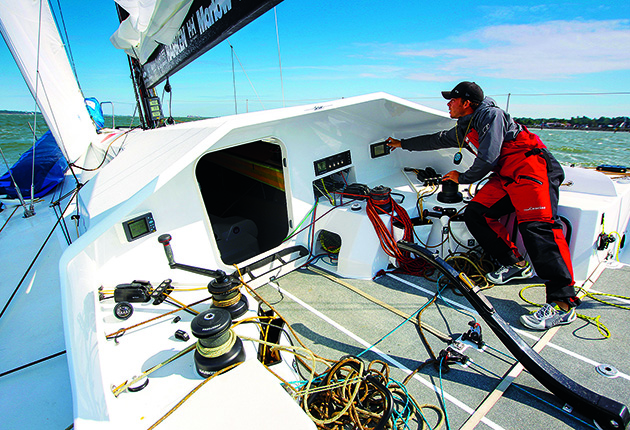
Many solo racers use the NKE system for the level of control it gives them. Credit: Paul Wyeth
These are designed to be used without the need for settings to be changed thanks to algorithms that quickly learn different conditions. However, both still require proper initial set up and calibration.
The Raymarine units have no user-adjustable parameters outside of three different modes: Performance, Cruising and Leisure.
These are analogous to the sport, manual and eco modes of many automatic cars that allow you to adapt the system’s response, without having to change gear yourself.
Even on a cruising yacht you may still want to switch to Performance mode when sailing downwind in strong breezes – this will increase the pilot response in a similar way to stepping up the Gain and Counter Rudder values of other systems.
The premise of Garmin’s Reactor series is also that users won’t need to change settings as a matter of course.
However, the values for Gain, Counter Gain and Auto Learn are available in the Dealer Commissioning pages of the menu system and can therefore be tweaked if necessary.

A pilot remote can be useful when going forward. Credit: Paul Wyeth
Until a few years ago all systems required the user to change settings to get the best from the unit in different conditions, although some have a degree of automatic switching between different modes.
Zest ’s Simrad N42 pilot computer, a model that was widely sold for more than a decade until around 2014, allows different sets of parameters to be saved for low boat speeds and running (when bigger helm movements are needed) and when beating or reaching at higher speeds (when smaller helm movements are necessary).
Even so, further fine-tuning is needed to cope efficiently with different wind strengths and sea states. It’s therefore worth noting settings that result in good course-keeping in different conditions.
I tend to keep in mind NKE’s simple grid of different points of sail and wind strengths.
Gradually filling this in over time and refining the numbers will provide a good set of data to ensure even older pilots can be made to steer the best possible course possible in different conditions.
I like to have it as a laminated card taped next to the pilot controllers, with space for annotations, as you identify settings that work best in different circumstances.
Boat autopilot set up & calibration
These elements are too often skimped, even with professionally installed systems, yet are critical for decent performance.
If the digital compass or 9-axis sensor is not properly calibrated or is installed too close to objects such as other electronics or ferrous materials it will not be accurate.
Fortunately compass calibration is simple, given flat water and space to turn the boat slowly through a turn and a quarter over a period of two or three minutes.
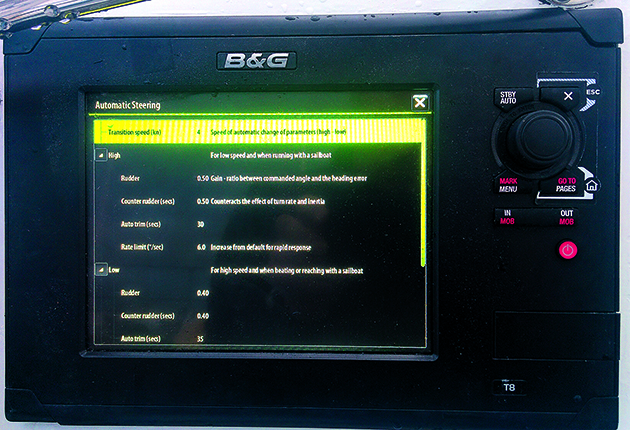
B & G boat autopilot systems have a clear and accessible calibration menu. Credit: Rupert Holmes
B&G systems generally allow easy access for this in the calibration menu, while for other brands it may be found in the Dealer Commissioning menu.
In all cases the manual for the pilot will guide you.
Equally, it’s easy to see that if the rudder sensor is not properly calibrated the system won’t accurately know when the rudder is central, its maximum angle in each direction, or the amount of play in the steering.
This can be easily set up without leaving the dock, again usually using the initial calibration menus and by measuring port and starboard helm angles when instructed.
Masthead wind sensors are rarely perfectly aligned, so instrument systems allow an offset figure to be entered. The best way to measure this is to motor head to wind in light airs.
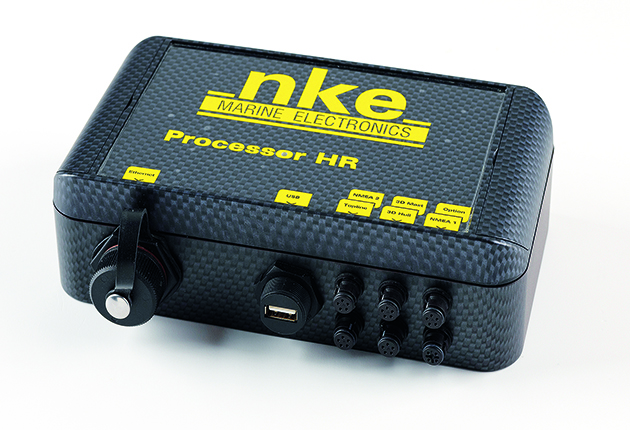
NKE pilots go a step further and allow a matrix of pre-set settings to be recorded
Accurate boat speed is also needed to calculate true wind strengths and angles. In addition, most pilots have an automated calibration process that helps the system to learn the boat’s characteristics and needs to be carried out while under way.
How much effort should go into this set up?
An hour or so will get reasonable results that can make a big difference to course keeping. However, it would be a mistake to treat these results as gospel.
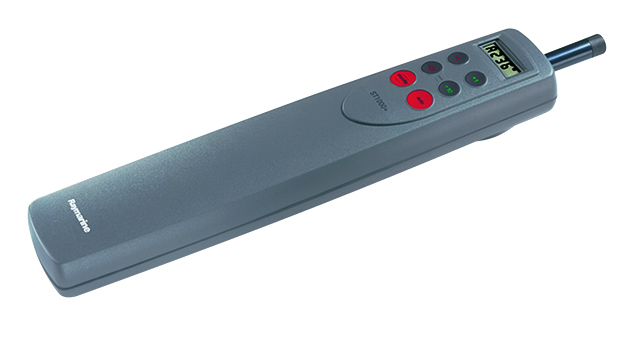
The Raymarine ST2000+ is a classic. It can be set to compass and wind trim mode, but calibration is limited to gain and damping
At the high end of the racing scene perfect calibration is seen as an almost unachievable holy grail, so professional navigators put a considerable amount of effort into improving their figures.
On the plus side, interfacing a boat autopilot with other marine electronics is no more difficult than for any other item.
The complexity of this task depends partly on how recent the various systems are and possibly on whether there’s a mix of products from different manufacturers, especially if they are from different eras.
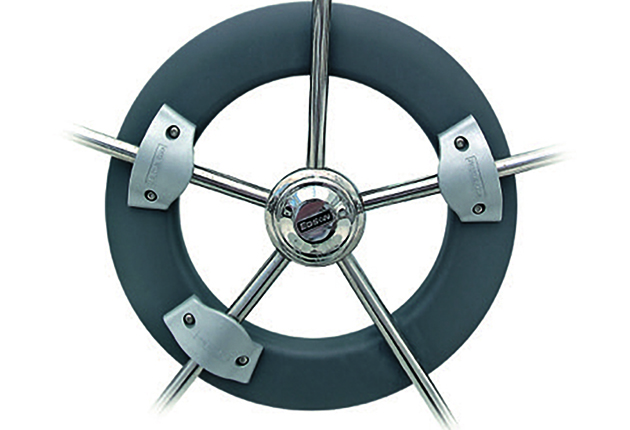
External wheel pilots will benefit from the addition of a rudder angle sensor
Integration tends to be easiest on recent plug-and-play NMEA2000-based systems, but may be more complex for electronics using older protocols.
When having a boat autopilot installed professionally it’s always worth ascertaining exactly what the quote includes. Is it simply bolting the units to the boat and connecting the wiring?
Will it be networked to the existing electronics? Does the quote include dockside checks and rudder sensor calibration?
What about set up that can only be done when under way, such as compass calibration and automated initial response settings?
Tiller Pilots
Tiller steered boats without a below deck quadrant that a pilot motor and rudder angle sensor can be connected to are at a disadvantage when it comes to finding a decent boat autopilot.
In addition, many all-in-one tiller pilot models have seen little development in the last couple of decades and have a number of inherent disadvantages.
Most are connected a long distance from the rudder stock, which reduces loads on their motor, but precludes a rapid response, and there’s no provision for a rudder angle sensor.
There’s also no clutch, so the unit has to be physically connected to the tiller and disconnected every time you switch from stand-by to auto mode and vice-versa.
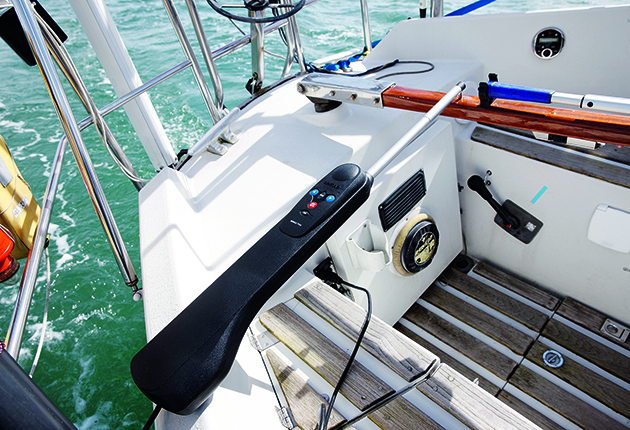
Tiller pilots can suffer from water ingress. Credit: Graham Snook/Yachting Monthly
In addition, the movement of the steering arm in and out of the housing changes the air pressure, making these units difficult to waterproof.
It therefore makes sense to invest in the type of tiller pilot whose motor is separate to the rest of the electronics.
That way, when water finds its way inside, it’s only likely to impact electrical connections that can often be successfully dried out, not complex electronics that may not survive.
Zest is pushed hard when racing and the system also has to survive the rigours of ocean sailing, so we searched widely for a better option.
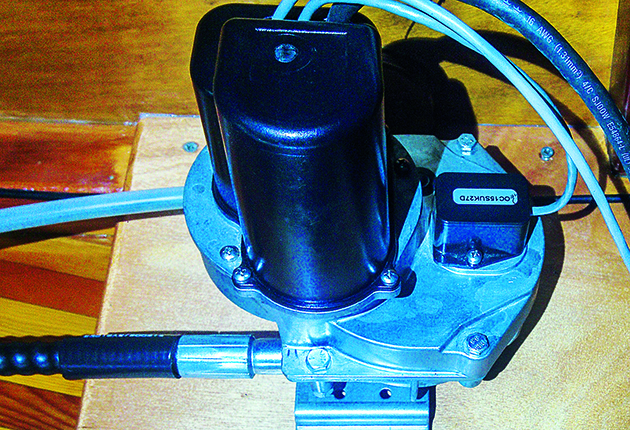
A B&G SD10 drive keeps the motor protected below decks. Credit: Rupert Holmes
The solution was a B&G SD10 drive, which has a motor below deck connected to the tiller via a Bowden cable.
It includes a rudder angle sensor and clutch, and is powerful enough to operate on a much shorter lever than most tiller pilots – 6.5 inches from the rudder stock, instead of 18 inches.
On Raymarine ST1000/2000+ tiller pilots only Rudder Gain and Rudder Damping settings can be adjusted by the user.
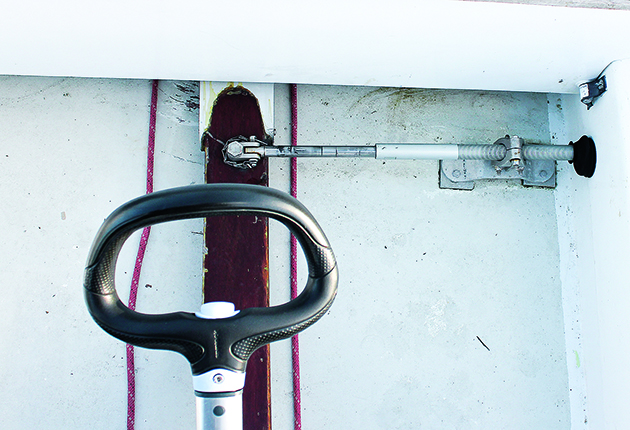
Only the end of the Bowden cable is exposed with a B&G SD10 drive. Credit: Rupert Holmes
As default these are set to 5 and 3 respectively on a scale of 1-9. The manual clearly explains how to do this via the keypad and small display on the unit.
Most of us struggle to commit these kind of procedures to memory, so it’s worth copying and laminating the relevant pages of the manual, along with a brief list of key points.
These can then be kept in the cockpit and used when tweaking the settings.
Boat autopilot reliability & redundancy
The better your boat autopilot the more likely you are to rely heavily on the system, which can cause problems when it stops working.
Pilot motors tend to have a very long life, though if you plan long-distance cruising it makes sense to carry a spare.
It’s also worth remembering that, if an NMEA2000-type database goes down, the pilot won’t have inputs from the compass and rudder angle sensor, and will stop working.
In the long-distance short-handed racing arena a lot of boats are fitted with two separate pilot systems.
If you’re fitting a new boat autopilot it makes sense to keep the old one as a back-up.
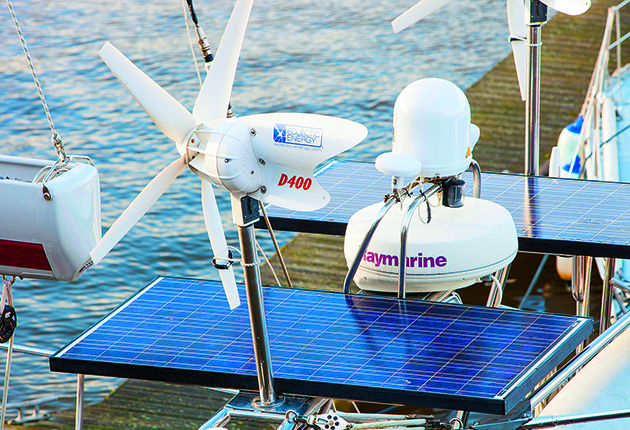
Have a variety of charging sources to power your boat autopilot. Credit: Alamy
Equally, if you already have a spare motor, it makes sense to fit it on the opposite side of the boat to the primary system, rather than stowing it in a locker.
The back-up boat autopilot can then be connected to a standalone system, without interfacing with wind data.
If the budget doesn’t stretch that far, an old- school system that can be bought on eBay for £2-300 may suffice for short-term use.
Equally, reliance on an electric pilot makes it important for boats venturing long distances to have more than one form of battery charging .
Fuel cells are used a lot in the racing community, with the engine then used only as a back-up.
However, this is a costly option and cruising yachts are more likely to opt for a large array of solar panels. Sailing with a decent boat autopilot is transformative.
Passage-making is easier and markedly less tiring, while unexpected situations are easier to handle if the boat can be left to steer itself without undue worry.
For many yachts, a small amount of time, plus some updated hardware, will make a big difference to performance.
Power Consumption
The amount of electrical power a pilot will consume varies hugely between different boats and in different conditions.
In light airs and a flat sea consumption will be very low – it may even be as little as half that of an MFD.
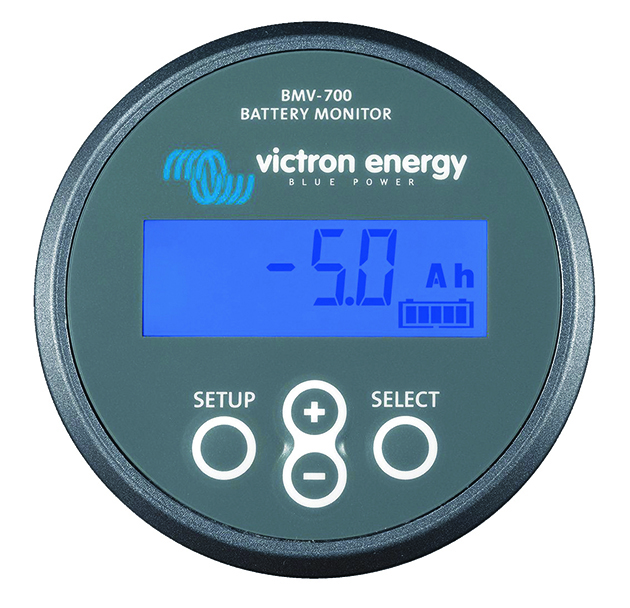
Keep a good eye on battery charge. Power usage will vary with conditions
However, off the wind in a lumpy sea state the unit will need to work much harder to maintain course, and average consumption may rise to 2-3 amps for most 35-38ft boats.
Newer systems that offer more accurate course-keeping need less power to run the motor, although their more sophisticated course computers may be more power hungry.
It’s also worth noting that turning up the settings to make an older system hyper responsive will use more power.
Keep your motor
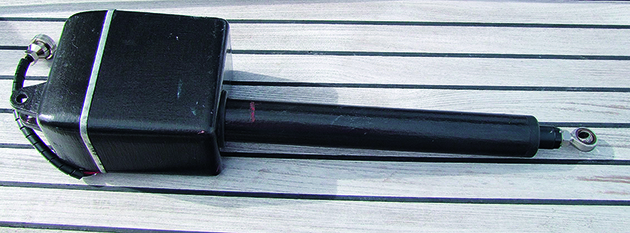
An old motor can work with new boat autopilot computers
The pilot motor is not an intelligent output from the pilot computer.
Therefore if you already have a decent pilot motor, it may only be the sensors or pilot computer that need upgrading to create a system with better performance.
- Types of Sailboats
- Parts of a Sailboat
- Cruising Boats
- Small Sailboats
- Design Basics
- Sailboats under 30'
- Sailboats 30'-35
- Sailboats 35'-40'
- Sailboats 40'-45'
- Sailboats 45'-50'
- Sailboats 50'-55'
- Sailboats over 55'
- Masts & Spars
- Knots, Bends & Hitches
- The 12v Energy Equation
- Electronics & Instrumentation
- Build Your Own Boat
- Buying a Used Boat
- Choosing Accessories
- Living on a Boat
- Cruising Offshore
- Sailing in the Caribbean
- Anchoring Skills
- Sailing Authors & Their Writings
- Mary's Journal
- Nautical Terms
- Cruising Sailboats for Sale
- List your Boat for Sale Here!
- Used Sailing Equipment for Sale
- Sell Your Unwanted Gear
- Sailing eBooks: Download them here!
- Your Sailboats
- Your Sailing Stories
- Your Fishing Stories
- Advertising
- What's New?
- Chartering a Sailboat
- Electronics & Instrumentation
- Sailboat Autopilot
The Helmsman's Friend - A Sailboat Autopilot
A sailboat autopilot is a thirsty beast, drinking your battery juice as if its life depended on it - which of course it does. So is it best to forego one of these and hand steer all day, for mile after mile, hour after hour? I don't think so...
So, providing your boat's batteries can keep up with its electrical appetite, an autopilot deserves a place on any sailboat, large or small.
Whilst larger boats will need a powerful inboard type working directly on the primary steering mechanism, one of the cockpit models will suit the smaller boats.
There are two cockpit versions of autopilots - one for wheel-steered boats and another for tillers.
All types rely on fluxgate compasses keep them on the straight and narrow.
Cockpit Versions of Sailboat Autopilots
For tiller-steered sailboats.
Autopilots for tiller steered vessels - or 'tillerpilots' as they are widely known - are the simplest form of sailboat autopilot, in which an electric motor is connected via a transmission mechanism directly to a push rod. The push rod extends or retracts to move the tiller.
Small tiller-pilots, suitable for boats up to around 4,500kg displacement, consist of a single module which includes the compass, the control unit, the motor and push rod.
In larger models, suitable for boats up to around 7,500kg displacement, the control unit and compass are separate modules. All tiller autopilots tend to be a little noisy - rather like the distant yapping of a small dog.
For Wheel-Steered Sailboats
Autopilots for wheel steered vessels are very similar to the tiller version, except that course corrections are applied to the wheel by a belt, rather than a pushrod.
Many offshore sailors choose to equip their sailboats with both windvane self-steering gear and an electronic autopilot - the former to steer the boat when sailing and the latter for use under power, when the electrical supply will be plentiful.
A Fully Integrated Sailboat Autopilot System
In recent years the trend towards instrument system integration has extended to include those cockpit autopilots that have a separate control/display unit.
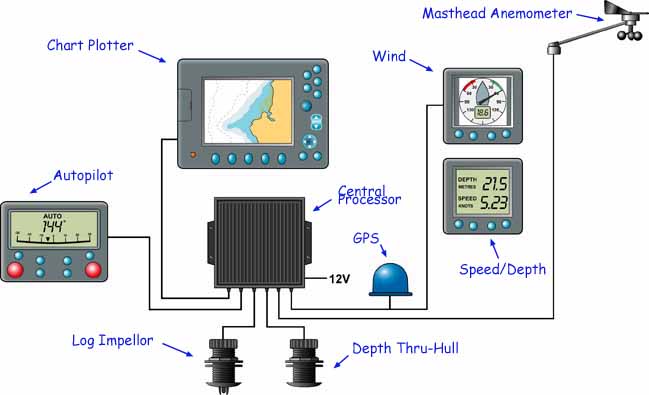
To get the most out of such units you need to integrate them with a compatible GPS or chartplotter , and a wind instrument either mounted at the masthead or at the stern of the boat. This gives three main operating modes:~
- Auto - the autopilot is locked onto a heading;
- Track - the autopilot is locked onto a track between two waypoints;
- Wind Vane - the autopilot maintains a course relative to the apparent wind. However, in practice if there's much of a swell running, neither a masthead instrument nor a stern-mounted one will give a particularly satisfactory result. The masthead unit will suffer from the motion of the boat, and a stern-mounted unit will be operating in a disturbed airflow. The resulting impulses have to be damped and processed to obtain a useful signal.
All sorts of data display and functionality is now available on the display unit - cross-track error, off-course alarm, waypoint proximity alarm, windshift alarm and so on.
One very useful function is 'Autotack', initiated by some judicious button pressing. Great news for a short-handed crew, who can now deal with the sails while the autopilot is putting the boat about.
Inboard Sailboat Autopilots
This type of autopilot can do all of the clever stuff mentioned above and lots more, being usually fully integrated with the boats navigational system.
They're much more powerful than the cockpit versions, suitable for large sailing boats and power boats, and a deal more expensive as a result.
Instead of connection to a tiller or wheel, they use push rods or hydraulic systems connected to the rudder post (or quadrant) to turn the main rudder directly.
Feeding the Beast
Power consumption of an electronic sailboat autopilot can be significant, the key factors affecting it being:~
- Sail trim - poorly trimmed sails and excessive weather helm;
- Sea state - bigger seas and increased yawing require more frequent steering adjustments;
- Autopilot setting - the more precise the course setting, the greater the work to be done by the autopilot;
- Boat displacement and waterline length - the more boat there is to move, the greater the greater the work to be done by the autopilot;
- Underwater shape - notwithstanding the tracking properties of a long-keeler, a keel-mounted rudder will require more force because it's impossible to balance, whereas a fully balanced spade rudder will be lightest on the helm.
It has to be said though, that if your battery charging regime has a weakness, an electronic sailboat autopilot will find it.
Linking a Tiller Pilot and a Vane Gear.
By removing the windvane from a vane-gear and connecting a small tiller autopilot in its place you can now use a vane-gear when under power. The pendulum or trim-tab now works with the autopilot, greatly reducing power consumption.
Some windvane gears, like the Auto-Helm and the Windpilot Pacifics for example, are constructed with this in mind and have the connection fitting built in. Other vane gear manufacturers don't recommend this approach, believing that the turbulence of the prop-wash can damage the pendulum blade bearings.
Next: Comparing a Sailboat Autopilot with Self-Steering Gears...

You might like to take a look at these...
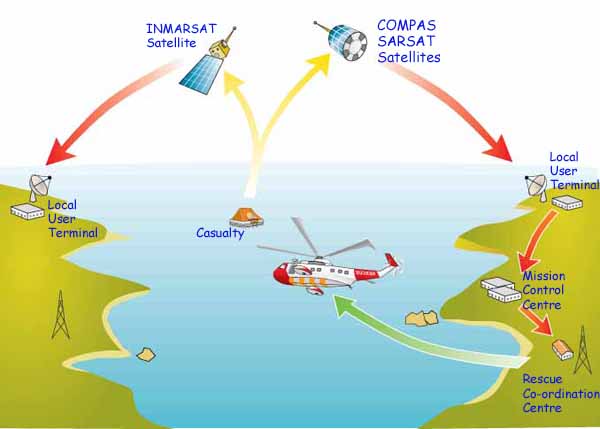
The GMDSS System; What Is It and What Does It Do?
Were it not for the GMDSS System we sailors would have no DSC, SATCOM, MSI, NAVTEX, EPIRB or SART Systems. If that leaves you none the wiser, read on
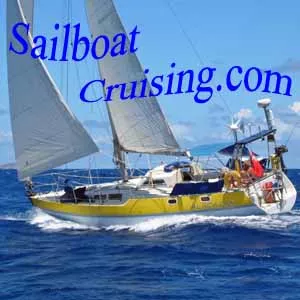
Is Small Boat Radar Right for Your Sailboat?
Expensive and power thirsty though small boat radar might be, there are times when you wouldn't really want to be without one. Here's what we found

The Marine GPS System Can Do A Lot More Than Position Fixing
The versatile marine GPS system provides identical functionality for both handheld marine GPS units and fixed GPS units. So which is best for your boat?

A Marine GPS Chartplotter; a Luxury or Necessity?
Once you've used a Marine GPS Chartplotter for the first time, my bet is that you wouldn't want to go to sea without one, and here's why
Recent Articles
The CSY 44 Mid-Cockpit Sailboat
Sep 15, 24 08:18 AM
Hallberg-Rassy 41 Specs & Key Performance Indicators
Sep 14, 24 03:41 AM
Amel Kirk 36 Sailboat Specs & Key Performance Indicators
Sep 07, 24 03:38 PM
Here's where to:
- Find Used Sailboats for Sale...
- Find Used Sailing Gear for Sale...
- List your Sailboat for Sale...
- List your Used Sailing Gear...
Our eBooks...

A few of our Most Popular Pages...

Copyright © 2024 Dick McClary Sailboat-Cruising.com

- Forums New posts Unanswered threads Register Top Posts Email
- What's new New posts New Posts (legacy) Latest activity New media
- Media New media New comments
- Boat Info Downloads Weekly Quiz Topic FAQ 10000boatnames.com
- Classifieds Sell Your Boat Used Gear for Sale
- Parts General Marine Parts Hunter Beneteau Catalina MacGregor Oday
- Help Terms of Use Monday Mail Subscribe Monday Mail Unsubscribe
Reverse or Neutral
- Thread starter jrocheleau
- Start date Sep 17, 2008
- Oday Owner Forums
- Ask An Oday Owner
I've heard conflicting views on what to do with your transmission when under sail. Should it be kept in neutral or reverse when sailing?
What I've been told is to put it in reverse when under sail. This came from the best diesel mechanic in our area. He's the guy that works on most of the boats including the ferry and cruise boats here. I don't know if the make and model make a difference. Ours is a Universal M25. Hope this helps!
Capt Jim24025
Depends on your engine and tranny Check with the engine manufacturer. My VolvoPenta w/saildrive says to use Reverse but my Perkins 107 manual says to use forward. In lieu of that, try them both and find out which one stops the prop from turning. You want to stop the shaft from turning to prevent excessive wear on the transmission and packing bearing. I've also been told that a stationary prop has less drag than a moving prop (but that seems counter-intuitive to me). Capt. Cook
My spin... Right on, Cap'n... I have a Volvo/Perkins MD2030 hooked up to a Volvo MS25S saildrive. Manual states when under sail, place shifter momentarily in reverse to stop prop and then place in neutral. Cheers, Bob
Hello All! Do you know right position of the Paragon reverse gear (Atomic engine) under sail? I didn't find it at the operation manual.
Konstantin said: Do you know right position of the Paragon reverse gear (Atomic engine) under sail? I didn't find it at the operation manual. Click to expand
Thanks a lot! Hello Rad! My name is Konstantin. I'm from Russia and I've bought the same boat (O'Day 32)! I see that it is really rare boat and there is not a lot of information. How long you own your boat?
Attachments

- This site uses cookies to help personalise content, tailor your experience and to keep you logged in if you register. By continuing to use this site, you are consenting to our use of cookies. Accept Learn more…

Cruising Fleet
The Lake Sunapee Cruising Fleet is a non-profit, volunteer organization dedicated to the sport of sailboat racing on Lake Sunapee. Our fleet has been in existence since 1984. From late May to early September each year, we race on Lake Sunapee every Wednesday evening and 5 Sunday afternoons. Parties interested in joining our fleet are encouraged to visit our dedicated fleet website.
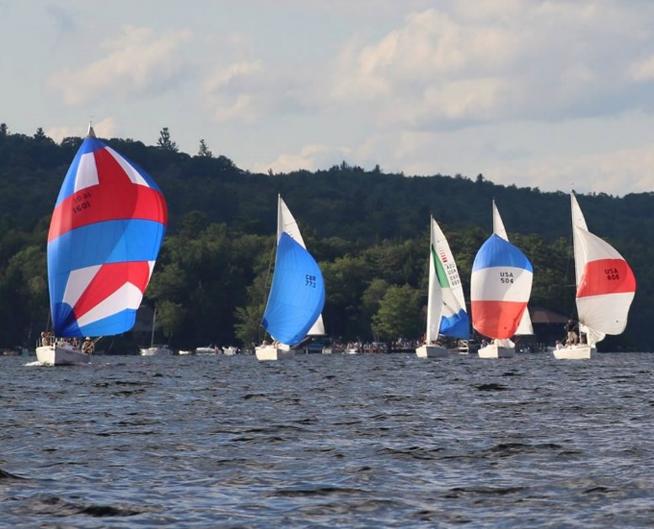
The Lake Sunapee Star Fleet is an active organization hosted by Lake Sunapee Yacht Club with weekly racing throughout the summer and an end of the year regatta that is open to both members and non-members.
34 STONE END RD, PO BOX 329, SUNAPEE, NH 03782 Coordinates: 43.3969° N, 72.0634° W
Phone : 603-763-5961 General Email : [email protected] MEMBERSHIP INQUIRIES: [email protected] Commodore: David Goddard Email: [email protected] Please note that LSYC is a seasonal club so the phone is not manned during the winter months. Use an email address above during the off season and we will get back to you as quickly as possible.
Employment Opportunities

Motor yachts
Charter Companies

C15917 - Dufour 520 GL (2019) - Milazzo, Italy
- 1 Instant Sailing Yacht Charter
- 1 Sailing destinations
- 1 Sicily region
Yacht basic info
Additional equipment list.
Inventory list
Available extras
Yacht layout.

Instant Sailing expert Tonka
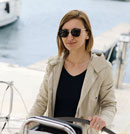
Similar yachts for charter

Sun Odyssey 519 - 5 + 1 cab. (2017) - 5 cab
Marsala italy.

Dufour 520 GL (2021) - 5 cab

Jeanneau 53 - 5 + 1 cab. (2011) - 5 cab
Olbia italy.

Hanse 505 - 5 + 1 cab. (2014) - 5 cab
Tonnarella italy.

Oceanis 51.1 (2019) - 5 cab
Salerno italy.

Dufour 520 GL (2019) - 5 cab
Palermo italy.

Oceanis 51.1 - 5 + 1 cab. (2021) - 5 cab
Scarlino italy.

Bavaria 50 Cruiser (2008) - 5 cab
Rosignano solvay italy.

Oceanis 46.1 (2021) - 5 cab

Oceanis 46.1 (5 cab) (2021) - 5 cab

D&D Kufner 54 (2020) - 5 cab

Sun Odyssey 519 - 5 + 1 cab. (2020) - 5 cab
Castellammare di stabia italy, price calculator, obligatory - not included in price:, charter period (saturday-saturday):, price calculation:, payment plan:, we are sorry but this yacht is not available or is under option in selected period, dear clients since our calendar is in real time, if you see all periods in red this means that this boat is not yet in booking for next season. please be kind and send us inquiry for custom offer., select date for real time prices, need more info - or help with planning, what happens when i click on "book now".
Once you click on Book Now button and fill out all information required, we will then confirm your request and automatically put chosen boat under option for 3 days, which means nobody else can book it in that period. In those 3 days, in order to confirm your booking you will have to make your first payment as stated in payment plan.
Which boat licence do I need?
To sail a boat in most countries you’ll need an internationally recognized boat licence, such as RYA, ICC, Radio License or CEVNI. However, this rule may vary from one country to another, therefore before departing on your trip we advice you to contact our team to see what kind of licences are accepted.
What is a security deposit?
Security deposit is refundable and you will receive it after check-out (after the boat has been inspected for any damages). However, if you cause damage you are responsible to the amount of security deposit ( it can't be exceeded ) and if your damage is less, the rest will be returned to you. Deposit price depends on the price of the boat.
What is a transit log?
Transit Log is one payment for following services (in most cases) : final cleaning, bed linen, base marina fees, diver check. Transit Log services may differ depending on charter company - you can always contact our support team which will be able to outline the specifics of Transit Log for your booking.
TIPS and FAQ
What is a security deposit for, what is a transit log, when do i hire a skipper, similar yachts available for charter.

- Seen 94512 times
Sun Odyssey 519 - 5 + 1 cab. (2017)
Marsala, Italy

- Seen 82368 times
Dufour 520 GL (2021)

- Seen 76754 times
Jeanneau 53 - 5 + 1 cab. (2011)
Olbia, Italy

- Seen 71730 times
Hanse 505 - 5 + 1 cab. (2014)
Tonnarella, Italy
Secure Checkout
- 1. Payment options 1.
- 3. Contact info 3.
- 5. Review your order 5.
Instant Sailing d.o.o.
Ninska 30, Split, Croatia
VAT: HR51723516898
Yacht details
Charter period
02.08.2017 - 09.08.2017
Till: 09.08.2017
Original price:
Our discount:
(-25%) - 386,00 €
Total price:
Amount to pay now:
IMPORTANT: all extras will be paid in base upon arrival
Bavaria Cruiser 41
Split, Croatia
Client name:
Mr. Marko Markić
Phone number:
00385 95 8168 254
[email protected]

Download pdf offer
- 1. Contact info 1.
- 2. Review offer details 2.
Send us an inquiry
Thank you for doing business with instant sailing, working hours:.
Monday - Friday: 08:00-19:00 (CET)
Saturday: 08:00-16:00 (CET)
Instant Sailing Privacy Policy

Contact info: Call : +385 95 802 8681 Email: [email protected]
Instant Sailing d.o.o. VAT: HR51723516898 Address: Ninska 30, Split, Croatia Offical website: www.instantsailing.com
Instant Sailing Privacy policy
This privacy policy has been compiled to better serve those who are concerned with how their 'Personally Identifiable Information' (PII) is being used online. PII, as described in US privacy law and information security, is information that can be used on its own or with other information to identify, contact, or locate a single person, or to identify an individual in context. Please read our privacy policy carefully to get a clear understanding of how we collect, use, protect or otherwise handle your Personally Identifiable Information in accordance with our website.
What personal information do we collect from the people that visit our blog, website or app?
When ordering or registering on our site, as appropriate, you may be asked to enter your name, email address, mailing address, phone number, credit card information or other details to help you with your experience.
When do we collect information?
We collect information from you when you place an order, fill out a form or enter information on our site.
How do we use your information?
We may use the information we collect from you when you register, make a purchase, sign up for our newsletter, respond to a survey or marketing communication, surf the website, or use certain other site features in the following ways:
- To improve our website in order to better serve you.
- To allow us to better service you in responding to your customer service requests.
- To quickly process your transactions.
How do we protect your information?
We do not use vulnerability scanning and/or scanning to PCI standards. An external PCI compliant payment gateway handles all CC transactions. We use regular Malware Scanning.
Your personal information is contained behind secured networks and is only accessible by a limited number of persons who have special access rights to such systems, and are required to keep the information confidential. In addition, all sensitive/credit information you supply is encrypted via Secure Socket Layer (SSL) technology.
We implement a variety of security measures when a user places an order enters, submits, or accesses their information to maintain the safety of your personal information.
All transactions are processed through a gateway provider and are not stored or processed on our servers.
Do we use 'cookies'?
Yes. Cookies are small files that a site or its service provider transfers to your computer's hard drive through your Web browser (if you allow) that enables the site's or service provider's systems to recognize your browser and capture and remember certain information. For instance, we use cookies to help us remember and process the items in your shopping cart. They are also used to help us understand your preferences based on previous or current site activity, which enables us to provide you with improved services. We also use cookies to help us compile aggregate data about site traffic and site interaction so that we can offer better site experiences and tools in the future.
We use cookies to:
- Help remember and process the items in the shopping cart.
You can choose to have your computer warn you each time a cookie is being sent, or you can choose to turn off all cookies. You do this through your browser settings. Since browser is a little different, look at your browser's Help Menu to learn the correct way to modify your cookies.
If users disable cookies in their browser:
If you turn cookies off, Some of the features that make your site experience more efficient may not function properly.Some of the features that make your site experience more efficient and may not function properly.
Third-party disclosure
We do not sell, trade, or otherwise transfer to outside parties your Personally Identifiable Information.
Third-party links
Occasionally, at our discretion, we may include or offer third-party products or services on our website. These third-party sites have separate and independent privacy policies. We therefore have no responsibility or liability for the content and activities of these linked sites. Nonetheless, we seek to protect the integrity of our site and welcome any feedback about these sites.
Google's advertising requirements can be summed up by Google's Advertising Principles. They are put in place to provide a positive experience for users. Google Adwords Policy
We use Google AdSense Advertising on our website.
Google, as a third-party vendor, uses cookies to serve ads on our site. Google's use of the DART cookie enables it to serve ads to our users based on previous visits to our site and other sites on the Internet. Users may opt-out of the use of the DART cookie by visiting the Google Ad and Content Network privacy policy.
We have implemented the following:
- Remarketing with Google AdSense
- Demographics and Interests Reporting
We, along with third-party vendors such as Google use first-party cookies (such as the Google Analytics cookies) and third-party cookies (such as the DoubleClick cookie) or other third-party identifiers together to compile data regarding user interactions with ad impressions and other ad service functions as they relate to our website.
Opting out:
Users can set preferences for how Google advertises to you using the Google Ad Settings page. Alternatively, you can opt out by visiting the Network Advertising Initiative Opt Out page or by using the Google Analytics Opt Out Browser add on.
California Online Privacy Protection Act
CalOPPA is the first state law in the nation to require commercial websites and online services to post a privacy policy. The law's reach stretches well beyond California to require any person or company in the United States (and conceivably the world) that operates websites collecting Personally Identifiable Information from California consumers to post a conspicuous privacy policy on its website stating exactly the information being collected and those individuals or companies with whom it is being shared. - See more at: consumercal.org
According to CalOPPA, we agree to the following:
Users can visit our site anonymously. Once this privacy policy is created, we will add a link to it on our home page or as a minimum, on the first significant page after entering our website. Our Privacy Policy link includes the word 'Privacy' and can easily be found on the page specified above.
You will be notified of any Privacy Policy changes:
- On our Privacy Policy Page
Can change your personal information:
- By emailing us
- By calling us
- By logging in to your account
- By chatting with us or by sending us a support ticket
How does our site handle Do Not Track signals?
We honor Do Not Track signals and Do Not Track, plant cookies, or use advertising when a Do Not Track (DNT) browser mechanism is in place.
Does our site allow third-party behavioral tracking?
It's also important to note that we do not allow third-party behavioral tracking
COPPA (Children Online Privacy Protection Act)
When it comes to the collection of personal information from children under the age of 13 years old, the Children's Online Privacy Protection Act (COPPA) puts parents in control. The Federal Trade Commission, United States' consumer protection agency, enforces the COPPA Rule, which spells out what operators of websites and online services must do to protect children's privacy and safety online.
We do not specifically market to children under the age of 13 years old.
Fair Information Practices
The Fair Information Practices Principles form the backbone of privacy law in the United States and the concepts they include have played a significant role in the development of data protection laws around the globe. Understanding the Fair Information Practice Principles and how they should be implemented is critical to comply with the various privacy laws that protect personal information.
In order to be in line with Fair Information Practices we will take the following responsive action, should a data breach occur:
- Within 7 business days
We will notify the users via in-site notification
We also agree to the Individual Redress Principle which requires that individuals have the right to legally pursue enforceable rights against data collectors and processors who fail to adhere to the law. This principle requires not only that individuals have enforceable rights against data users, but also that individuals have recourse to courts or government agencies to investigate and/or prosecute non-compliance by data processors.
CAN SPAM Act
The CAN-SPAM Act is a law that sets the rules for commercial email, establishes requirements for commercial messages, gives recipients the right to have emails stopped from being sent to them, and spells out tough penalties for violations.
We collect your email address in order to:
- Send information, respond to inquiries, and/or other requests or questions
- Process orders and to send information and updates pertaining to orders.
- Send you additional information related to your product and/or service
To be in accordance with CANSPAM, we agree to the following:
- Not use false or misleading subjects or email addresses.
- Identify the message as an advertisement in some reasonable way.
- Include the physical address of our business or site headquarters.
- Monitor third-party email marketing services for compliance, if one is used.
- Honor opt-out/unsubscribe requests quickly.
- Allow users to unsubscribe by using the link at the bottom of each email.
If at any time you would like to unsubscribe from receiving future emails, you can email us at
- Follow the instructions at the bottom of each email and we will promptly remove you from ALL correspondence.
Contacting Us
If there are any questions regarding this privacy policy, you may contact us using the information below.
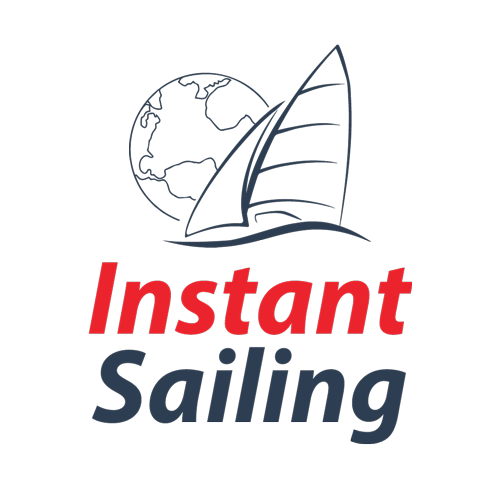
David Hadaller
- Born: 01.01.1999
- Living in: Zagreb, Croatia
- Languages: EN, DE, HR, ES
- Email: [email protected]
- Mobile: +385 98 654 3217
- Jobs: Skipper, hostess
English language:
+44 203 807 3932
+1 866 889 6996
+385 91 5424 630
German language:
+43 7209 02390
Italian language:
+385 21 469 031
French language:
Czech language:, croatian language:, russian language:.

Please verify you are a human
Access to this page has been denied because we believe you are using automation tools to browse the website.
This may happen as a result of the following:
- Javascript is disabled or blocked by an extension (ad blockers for example)
- Your browser does not support cookies
Please make sure that Javascript and cookies are enabled on your browser and that you are not blocking them from loading.
Reference ID: 41664cdb-774d-11ef-910d-53bc0f5bade3
Powered by PerimeterX , Inc.
Cruise Routes (Interactive Map)
Request a quote download brochure
Russian River Cruises
- Find your cruise
- Moscow — St. Petersburg
- Moscow — Astrakhan
- Astrakhan — St. Petersburg
- St. Petersburg
- Cruise Highlights
- News & Travel Tips
Russia is again welcoming travelers!
- A negative PCR test is all that's needed to enter Russia
- Regular flights are now operating to / from Russia
- Visas can be issues quickly (Volga Dream provides your invitation)
- All Volga Dream personnel and guides are fully vacinated
- Bookings are transferable without penalty for 12 months
- Volga Dream arranges PCR-tests if needed for your outbound flight
Check our COVID-19 Policy page to learn more.
Lorem Ipsum
Luxurious river cruises in russia.
Explore authentic Russian cities. Enjoy premium service and engaging activities as you sail the Volga River.

2022 Cruise Season
Join our signature small group journeys and cruise in luxury along the Russian Volga river!
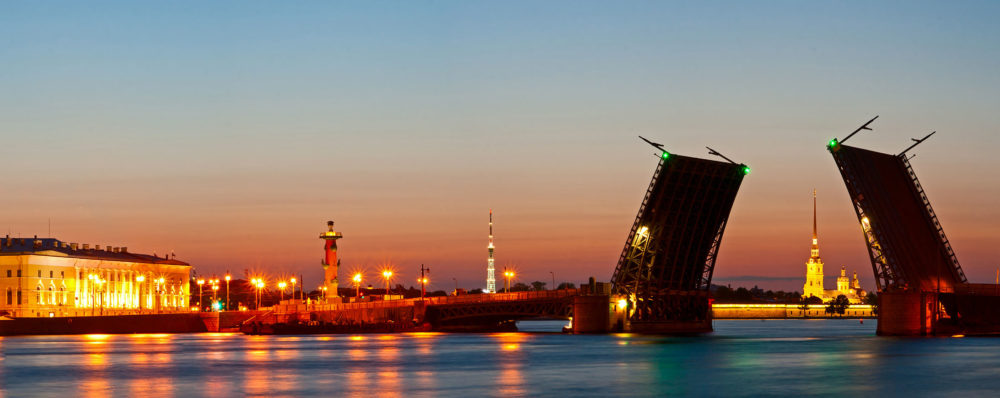
The Russian Odyssey
An extended 'South to North' view of Russia from Astrakhan to St. Petersburg through Moscow.

Explore Moscow, St. Petersburg and Russia’s Golden Ring in greater depth. Stay at gorgeous Four Seasons hotels. Enjoy special access to iconic cultural sites.

Lower Volga
Treat yourself to an unforgettable experience cruising the Volga river from Moscow to Astrakhan. The tour includes 2 nights in Moscow.

Find Your Cruise
Select destination Moscow — St. Petersburg Moscow — Astrakhan Astrakhan — St. Petersburg
View all months
A Volga river cruise is more than a geographical voyage; it’s also a journey through Russia’s rich and captivating history. No other experience takes you so completely to another place and time. The Volga is Europe’s longest and largest river; it meanders through the stories of Ivan the Terrible and his rise to power, the two historic ‘Greats’ Peter and Catherine, and then on into today. It’s a unique opportunity to see modern Russia in the context of its intriguing history, ably assisted by friendly and professional academics and tour guides. A Volga Dream Russian river tour promises to leave you with an unforgettable afterglow of fond memories.

Moscow to St. Petersburg River Cruise
Moscow and St. Petersburg are Russia’s best-known cities, but the towns of Russia’s historic Golden Ring are delightful too. The luxurious Volga Dream offers a unique opportunity to visit these Russian gems by sailing gently along the Volga River on an unforgettable cruising experience. In small, exclusive groups you’ll enjoy preferential access to some of Russia’s most significant cultural sites.

Moscow to Astrakhan River Cruise
Your River Cruise on the luxurious MS Volga Dream takes you from Moscow along Russia’s grand Volga River to the legend that is Volgograd (formerly Stalingrad) and Astrakhan on the Caspian Sea. Along the way, you’ll discover the treasures of Yaroslavl, the oldest city on the Volga, medieval Nizhniy Novgorod and beautiful Kazan, the ancient Tatar capital. We plan our tour carefully to combine the very best of Moscow with a world-class Volga River cruise.
Discover Russia with MS Volga Dream - Click-through map

We love hearing from guests about their time in Russia and one comment often hear is how surprised people are by the Russian capital. We can’t say for certain what people expected but we do know that it’s always far removed from what they imagined! It’s been called a modern metropolis, a cosmopolitan city, an historic gem, an architectural treasure and a cultural powerhouse, among other descriptions. Majestic Moscow has always surprised our guests and left them with lasting and fond memories.
Russia’s famous Golden Ring is an archipelago of historic towns surrounding Moscow. Uglich is one of the oldest and was founded under Igor, the last Varangian prince. It once resisted the Mongol invasion and its ancient walls saw the grisly murder of young Dmitri, son of Ivan the Terrible. The impressive Church of St. Dmitri on the Blood, with its classic onion domes and blood red walls, is a fine example of classic Russian architecture. The tour ends with an enchanting choral concert.
This, the oldest city on the Volga River, and now a UNESCO World Heritage site, boasts a wealth of ancient orthodox treasures. The impressive Transfiguration of the Savior, adorned with murals depicting St. John’s apocalyptic visions can be seen in the Spassky Monastery. The Church of St. Elijah the Prophet is decorated with an awe-inspiring selection of rich frescoes. For a real taste of pre-revolutionary Russia, visitors are entertained by a costumed reception at the Governor’s House.
Close to the shores of White Lake once were the ‘tsar’s fishing grounds’. It lies in a place so serene that ancient monks chose to build no fewer than three holy sites here, including the Ferapontov Monastery. Listed as a UNESCO World Heritage site, its chapels boast magnificent frescoes by Dionysius, one of Russia’s most renowned icon painters. The Kirillo-Belozersky Monastery was a refuge for many nobles during tumultuous times and later a fortress that successfully repelled invading armies.
The Karelia region is a vast and naturally beautiful wilderness that spreads all the way from St. Petersburg to the Arctic Circle. The glorious island village of Kizhi consists almost entirely of the traditionally styled wooden buildings of ‘Old Russia’. Among them is the famous Transfiguration Church built in 1714. Remarkably, and in testament to the craftsmen of the time, not a single nail was used in its construction! Kizhi is one of the favorite stops on the river cruise to St. Petersburg.
A typical rural hamlet brought to life by warm and welcoming villagers. Volga Dream guests are invited into local homes to enjoy classic Russian fare, tea with jam and ‘pirozhki’ (pies). Enthusiastic hosts share Russian traditions and the appeal of village life while proudly showing off their scrupulously kept homes and kitchen gardens. The tour continues with a brief bus ride to see a unique World War II memorial and then, for a real glimpse of Russian life, a visit to a local primary school.
Nizhny Novgorod
This was once a wealthy city thanks to its proximity to rich eastern trading routes. During the Soviet era, the city was closed to outsiders because of its military importance. It’s also where many political prisoners were sent to live out their days in exile. The 16th-century Kremlin ramparts offer spectacular views and the city is known for its elaborately decorated churches. For Volga Dream cruise guests, the highlight of the day is an evening folk concert performed by local children.
Sailing along the Volga river, the riverbank gradually ceases to be dominated by Orthodox churches. Instead, beautiful mosques appear as the river crosses into Tatarstan where the first stop is scenic Kazan, the region’s capital. Inside the white walls of the citadel, the famous Kul Sharif mosque and the old Cathedral of Peter and Paul stand side-by-side symbolizing the two faiths’ long and peaceful coexistence in the region. A concert of traditional Tatar music ends the Volga Dream tour in Kazan.
Passing the Zhigulevskie Mountains offers wonderful views from the sundeck before touring the city. One of the key attractions is the fascinating Space Museum, which offers a revealing glimpse of how the Soviet Union pursued its ambitious journey to the cosmos. The town is also noted for its beautiful esplanade, perfect for a relaxed stroll beside the Volga river. This in turn leads to the Samara State Art Museum. Founded in 1897, it is home to a collection of more than 16,000 works of art.
This city is best known for its close associations with cosmonaut, Yuri Gagarin. The Russian hero who achieved worldwide fame as the first man in space lived and studied here. Saratov used to be home to a large German community, a heritage that can still be seen in the local architecture. The Volga Dream tour visits the Radishchev State Art Museum, the first picture gallery in Russia outside Moscow and St. Petersburg.
Originally called Tsaritsyn, the city was renamed Stalingrad from 1925 to 1961 in honor of the USSR’s leader. During World War II, the city’s residents put up a heroic defense, repelling an advancing Nazi invasion. The battle for Stalingrad has gone down in history as a pivotal moment in the bloody conflict on the eastern front. The most ferocious and deadly fighting took place on Mamayev Hill, where an imposing memorial now stands close to the excellent Battle of Stalingrad Panorama Museum.
Saint Petersburg
If Moscow surprises, then St Petersburg delights. Peter the Great founded the city to showcase Russia’s newfound enlightenment. He wanted to show the modern world a cultured and advanced society. In short, he built the city to impress and in that he succeeded splendidly! The striking buildings were designed by some of the finest architects Europe had to offer and even now, the ‘Venice of the North’ never fails to enchant with its spectacular buildings and impressive canal network. It is a city of true grandeur.
Cocktails with the Captain
Commanding any ship is a complex role that calls for a long list of skills. Captains know their vessels inside out as well as well as the routes they sail and when things don’t go to plan, they have to make instant decisions. Above all though, the most important part of the job, underpinning everything they do, is to keep the ship and everyone aboard safe. The Captain’s cocktail party is a great and a wonderful opportunity for passengers and crew to get acquainted as the gets underway.
Matryoshka doll painting
There is nothing more typically Russian than a Matryoshka. It embodies the fact that there’s always something deeper to be found in every aspect of Russian life. Learning the traditional designs and techniques used to decorate these iconic dolls offers a pleasant diversion and some cathartic creativity!
Superb Service & Dining
Our restaurant serves the highest standard of international cuisine, freshly made by our Cordon Bleu Chef. Choose either a sumptuous buffet or set menu for lunch while dinner is always four or five courses with full service. High praise for the exquisite quality of meals is yet another constantly recurring feature in feedback from our guests.
Meet the Professor
From the Mongol hordes to Soviet times, Russia’s history is, like all of Europe’s, a complex web of political intrigue, war and peace, trade and treaties, as well as heroes and villains. Academics devote whole lifetimes to studying Russia’s long past and one of them presents a series of lectures shedding light on everything from Gorbachev to Chekhov, Khrushchev to Ivan the Terrible and of course, contemporary Russia. Our Professor is on board throughout the river cruise for informal conversation.
Beginner’s Russian
The Russian language can be rather beautiful and poetic and we know that many seasoned travelers enjoy trying their hand at different languages. Our onboard teachers provide an introduction to the riches of Russian, so guests can try out a few useful words and phrases on real Russians during the exciting river tours from Moscow to St. Petersburg or from Moscow to Volgograd!
Russian tea tasting
The drink we tend to associate with Russia is vodka, but tea, in fact, is the much more universal beverage of choice throughout the country. Guests will get acquainted with the Russian tea etiquette, a fundamental component of the country's social culture, and enjoy the traditional tea ceremony while cruising from St. Petersburg to Moscow or taking a Grand Volga river tour.
Russian Dinner & Vodka Tasting
All our dining is international but for Russian Dining night, the Chef includes a selection of traditional Russian dishes: Chicken Kiev, Kulebyaka and no Russian table is complete without Borsch. To add to the ‘Taste of Russia’ optional Russian dress, or at least a touch of Russian style, is provided along with enthusiastic help from our staff!
Russian Cooking Class
A plate of pelmeni might not look like much to the untrained eye, but it forms the heart of Russian cuisine and culture. Basically, it's a type of dumpling: small portions of meat and onion wrapped in a thin sheet of unleavened dough and boiled, a little like ravioli. Guests can join a Russian cooking class onboard the MS Volga Dream to learn how to cook this delicious Russian dish.
Tchaikovsky and Rachmaninov Piano Recital
Some of the greatest classical music ever written comes from Russia. It’s hard to imagine a more fitting stage for a virtuoso solo recital by our resident concert pianist than the mighty Volga or a better backdrop than the heart of Tchaikovsky and Rachmaninov’s own serene homeland.
Russian River Cruise Aboard Volga Dream
Moscow to St. Petersburg
Why Volga Dream

Family Owned & Operated
MS Volga Dream is Russia’s only family-owned river cruise ship. She can accommodate up to 100 guests, far fewer than most other cruise ships on the river making for a uniquely friendly and intimate atmosphere aboard.

Five-Star Central Hotels
We at Volga Dream are completely convinced that, our guests should stay in great 5-star hotels in Moscow and St. Petersburg within comfortable walking distance of all the major attractions, theaters and restaurants, rather than having to waste time in traffic.
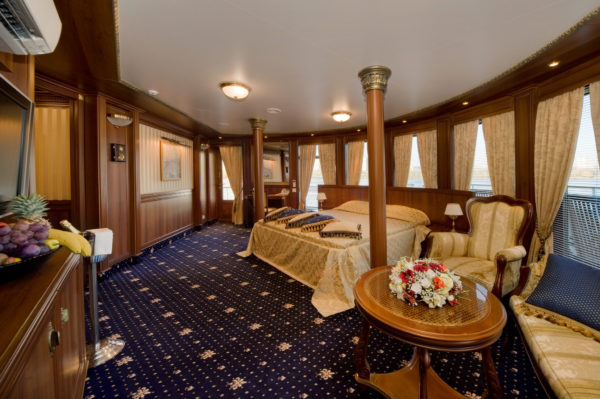
Luxurious Accommodation
The MS Volga Dream is the most intimate and elegant 5-star cruise vessel in Russia. She boasts 56 cabins, all river facing, ranging from comfortable Standard Cabins to spacious Junior Suites and the luxurious forward facing Owner's Suite.

Russian Cultural Experience
Explore Russia's past with the help of professional tour guides. Our on-board program includes fascinating talks on Russian history and politics, Russian language lessons, a festival of Russian cuisine (including vodka tasting!), and much more.

Gourmet Dining
Our on board restaurant serves international cuisine to the highest standard, all freshly made by our Cordon Bleu Chef. For Russian Dining night, he prepares a selection of traditional Russian dishes: Chicken Kiev, Kulebyaka and Borsch.

Tailored Service
All our service crew members are native Russians who are fluent in English and handpicked by the Owner. Proudly, the Volga Dream is famous for her hard working and very hospitable personnel who take care of every aspect of your life aboard.
Download Our Brochure
It's never been easier to plan your next holiday in Russia. Download our free brochure to learn more about authentic Russian river cruises.

Escape the hassle and bustle and add a satisfyingly informative element to your trip and bring together a colorful mosaic of people, history, traditions, religion, music and art. These are the many strands that time has woven into what is known today as Russia.
What people are saying
Jacqueline Lapwood
Great Britain
Rick Dowden
United States
Alexander Powell
Monique Verbrugge
Peter & Annemieke English
Philippa Calnan
Sign Up for Our Newsletter
Sign up for our newsletter and keep up to date with the latest offers, savings and news at Volga Dream

COMMENTS
The Garmin Ghc 20 Marine Autopilot Helm Control is your best sailboat autopilot for these types of adventure. This amazing autopilot is designed with a 4-inch display that can improve your nighttime readability. This display is glass-bonded and comes with an anti-glare lens that is essential in preventing fog and glare in sunny conditions.
6 Best Sailboat Autopilot Systems and How to Choose: 1. Simrad TP10 Tillerpilot 2.Raymarine Pilot EV-400 Autopilot 3.B&G (Simrad) NAC-3 Core Pack ... Sail Boat Auto Pilot Components. Today's autopilots are complex electronic systems built of several components that work together to get the job done. Most advanced autopilots consist of the ...
Quick Answer - The Best Autopilot For Sailboats. Raymarine ST1000 Plus Tiller Pilot. View at Amazon. Simrad TP10 Tillerpilot. View at Amazon. Raymarine M81131 12 Volt Type 2 Autopilot Linear Drive. View at Amazon. Garmin GHC 20 Marine Autopilot Helm Control. View at Amazon.
Sailboats: To choose a cockpit-mounted sail autopilot, select a tiller pilot (like Simrad's TP-10, TP-22 or TP-32 or Raymarine's EV-100 Tiller) or wheel pilot that matches your boat's displacement, following a conservative approach of moving up a size when in doubt, and adding 20% to the boat's displacement for typical cruising gear.
Modern Sailboat Autopilots. Loaded with features and light on power consumption, today's autopilots are a sailor's best friend for the long haul. When properly installed, the autopilot drive should be connected to the rudder shaft using a dedicated bracket rather than being somehow attached to the steering quadrant. Photo Courtesy of Edson Marine.
The ACU-100 (£420) is for smaller sailing yachts using the EV-100 tiller or wheel pilot. The ACU-200 (£845) is for any vessel with one of the company's Type 1 drive units. It can supply up to 7A of power to the drive unit and suits most boats up to 11,000kg laden displacement.
The NAC-3 Autopilot Computer is the basic model in the company's Triton range that's designed for boats over 33ft (10m). It takes inputs from the RF25 rudder angle sensor and Precision 9 ...
The EV-200 Sail Pilot is a complete autopilot solution for mid-sized sailboats with mechanical steering. The Sail Pilot kit includes the p70s color, pushbutton autopilot controller, EV-1 sensor core, ACU-200 actuator control unit, a Type 1 mechanical linear drive and an Evolution cabling kit. The Type 1, 12-Volt mechanical linear drive works on ...
EV-100 Wheel Sail is designed for sailboats with pedestal-mounted wheel steering. The Wheel Drive is easy to install, fits most types of wheels with a clean fully enclosed design and a robust clutch engagement mechanism. It's Smart Rudder Sense TM enabled so a rudder reference transducer is not required. The p70 control head is designed for ...
Electronic autopilots are obviously now the dominant technology in self-steering and the most modern refinements, such as the 9-axis sensor, sailing specific algorithms and the powerful remote ...
If the gain is set too low the boat will take too long to return to the desired course. On the other hand, if gain is too high, the boat will overshoot and yaw each side of the set course. This was a common problem with early pilots where gain was often the only parameter that could be adjusted. 2. Counter Gain.
Raymarine Evolution EV-200 Sailing Vessel Linear Autopilot Pack with P70S - T70158. $3,699.99. Simrad NAC-3 Autopilot Computer - 000-13250-001. $1,649.00. Raymarine EV-1 Sensor Core - E70096. $717.99. Raymarine Evolution EV-200 Sailing Vessel Autopilot Pack with P70S Control Head - T70155. $2,199.99.
With its solid-state 9-axis Attitude Heading Reference System (AHRS), the GHP Reactor ™ autopilot series holds your course even when your boat is pitching and rolling in rough water. Offers flexible installation options and requires a minimum amount of commissioning and calibration. The result is that everyone onboard enjoys a comfortable ...
Feeding the Beast. Power consumption of an electronic sailboat autopilot can be significant, the key factors affecting it being:~ Sail trim - poorly trimmed sails and excessive weather helm;; Sea state - bigger seas and increased yawing require more frequent steering adjustments;; Autopilot setting - the more precise the course setting, the greater the work to be done by the autopilot;
p70Rs Autopilot Control Head. $729.99. Compare. Add to Cart. Load More. 1 - 24 of 113 Items. Explore top marine autopilots from leading brands like Raymarine, Garmin, and Simrad. Enjoy hands-free navigation with advanced features like GPS integration and precise course control. Shop now for reliable autopilot systems.
From self-contained tiller pilots to the game-changing, self-calibrating Evolution boat autopilot series, we offer marine autopilot systems for a wide range of power, sail and fishing boat applications. Boat Autopilots. Autopilot Packs. Learn more. Autopilot Control Heads. Learn more. Autopilot ACU. Learn more.
The Paragon tranny reverse position has to be held firmly for the plates to engage so putting this transmission in reverse while sailing will not stop the prop from turning and will cause wear on the transmission,the forward gear is the correct position because there is a noticeable click to lock it in gear thus stopping the prop from turning.
EV-400 Sail Overview. The EV-400 Sail Pilot is the perfect solution for large sailboats with mechanical steering. The EV-400 Sail Pilot kit includes the p70s color, pushbutton autopilot controller, EV-1 sensor core, ACU-400 actuator control unit, rotary rudder feedback unit, and an Evolution cabling kit. Choose any Type 2 or Type 3 mechanical ...
The EV-100 Wheel Pilot is a complete autopilot solution for wheel-steered sailboats. Designed for do-it-yourself installations, the EV-100 Wheel Pilot's externally mounted drive mounts in the cockpit, attached directly to the spokes of the boat's steering wheel. The EV-100 Wheel Pilot delivers precision autopilot control using the intelligent ...
SUNAPEE, NH 03782. Coordinates: 43.3969° N, 72.0634° W. Phone : 603-763-5961. General Email : [email protected]. MEMBERSHIP INQUIRIES: [email protected]. Commodore: David Goddard. Email: [email protected]. Please note that LSYC is a seasonal club so the phone is not manned during the winter months. Use an email address above during the ...
Charter - Moscow Mule - Dufour 520 GL (2019) Sailboat in Milazzo, Italy. Price range: 1840€ - 10000€, 5 cabins, 12 berths. Rent this Dufour 520 GL online and enjoy Sicily region - Instant Sailing boat rentals
Raymarine software version 1.21 is also a minimum requirement. EV-100 Tiller is designed for tiller steered sailboats. The p70 autopilot control head is a push-button controller designed primarily for sailboats. Advanced LED backlighting offers low power consumption and delivers vibrant color and contrast. Wide horizontal and vertical viewing ...
as you sail the Volga River. Find your cruise. 2022 Cruise Season. Join our signature small group journeys and cruise in luxury along the Russian Volga river! ... The luxurious Volga Dream offers a unique opportunity to visit these Russian gems by sailing gently along the Volga River on an unforgettable cruising experience. In small, exclusive ...